







“My own years as a teenager were marred by a sinister regime that thought it had all the answers; its influence grew - infiltrating schools and civic bodies, as well as politics and even religionbefore it was fully recognized for the monster it was. It banished God and thus became impervious to anything true and good.”
POPE SPEAKS TO YOUTH PAGE 11

■ By Catholic News Service
ROME (CNS) - Cardinal Alfonso Lopez Trujillo, president of the Pontifical Council for the Family, died on April 19 at Rome’s Pius XI clinic, where he had been hospitalized since early April with a respiratory infection. He was 72.
Pope Benedict XVI called the cardinal a “tireless pastor” who generously served the church and “the Gospel of life.” The Pope, Continued - Page 2



The Parish - Pages 4-5
The Nation - Pages 6-7
Perspectives - Vista 4 - Pg 9
Benedict XVI in US 10-13
Panorama - Page 14
Classifieds - Page 15
Last Sunday was Palm Sunday under the Julian Calendar, celebrated by Eastern Catholics and Orthodox around the world. Matthew Biddle visited Perth’s Ukrainian Catholics for Eastern Easter.







Conrad of Parzham
1818-1894
feast – April 21
Born in Bavaria, in Germany, Conrad Birndorfer was the youngest of nine children of pious farmers. Even as a youth, he had a strong devotion to Our Lady. At age 16, after his parents died, he combined running the family farm with a life of prayer and charity. He joined the Capuchins as a lay brother in 1849 and made solemn vows in 1852. For 40 years, he was the doorkeeper at the famous Bavarian shrine of Our Lady of Altotting where he counseled thousands of pilgrims, helped care for abandoned



One of the most outstanding line-ups of international ethicists ever to gather in Australia will participate in the Truth and Faith in Ethics conference at the University of Notre Dame Australia’s Sydney Campus from 24-27 June 2008.
World renowned philosophers such as Profs John Finnis (Oxford), Nancy Sherman (Georgetown), Robert George (Princeton), John Haldane (St Andrews),
Julia Annas (Arizona), Raimond Gaita (London, ACUNational), Anthony O’Hear (Buckingham), Jude Dougherty (Catholic University of America) and many others will address a range of topics on the relation of ethics and faith.
Some subjects that will be dealt with over the three days are; ‘Human worth, respect for persons and religious commitments,’ ‘Friendship: poignancy and para-
dox’ and ‘Public reason in bioethics.’
The conference will also include a public debate between Profs John Haldane (St Andrews) and Raimond Gaita (London and ACUNational). The debate is entitled, ‘Is God necessary for morality?’
Venues are limited in size so please do not delay to register. Contact ndethicsconference@nd.edu.au for further details.
“Those who obey the commandments, Jesus says in today’s Gospel, are the ones who really love Him. Does my stewardhip reveal my love for Jesus? SHARON HUECKEL, STEWARDSHIP BY THE BOOK
For further information on how stewardship can build your parish community, call Brian Stephens on 9422 7924.
29T St Catherine of Sienna, virgin, doctor of the Church (M)
Wh Acts 16:22-34 Thrown into prison
Ps 137:1-3.7-8 God’s love eternal
Jn 16:5-11 Sad at heart
30W St Pius V, Pope (O)
Wh Acts 17:15.22-18:1 All God’s children
Ps 148:1-2.11-14 Praise God’s name
Jn 16:12-15 The Spirit of truth
MAY
1T St Joseph the worker (O)
Wh Acts 18:1-8 Aquila and Priscilla
Ps 97:1-4 God’s saving power
Jn 16:16-20 Sorrow turned to joy
2F St Athanasius, bishop, doctor of the Church (M)
Wh Acts 18:9-18 Do not be afraid
Ps 46:2-7 Shouts of joy
Jn 16:20-23 You are sad now
3S SS PHILLIP AND JAMES, Apostles, feast Red 1 Cor 15:1-8 The gospel I preached
Ps 18:2-5 Work of God’s hands
Jn 14:6-14 If you know me
4S THE ASCENSION OF THE LORD, Solemnity
Wh Acts 1:1-11 Has the time come?
Ps 46:2-3.6-9 God is king Eph 1:17-23 Spirit of wisdom
Mt 28:16-20 I am with you
5M
Wh Acts 19:1-8 Baptised in Jesus
Ps 67:2-7 Sing to God
Jn 16:29-33 Do you believe?



Graced: Volunteers help located survivors behind the burnt cockpit of a crashed Hewa Bora Airways passenger jet in Goma, capital of Democratic Republic of Congo’s eastern North Kivu province. Two Xavierian missionaries were among the survivors of the April 15 crash that killed more than 70 people. The Congolese domestic airliner was taking off from the eastern city of Goma, when one of the plane’s tires blew out just before liftoff, forcing the pilot to abort the takeoff. However, the runway ended and the plane crashed into a crowded market district and caught fire, officials said. The plane split open upon impact, allowing many of the survivors - including the missionaries - to escape before flames engulfed the jet.
PHOTO/LAUREN VOPNI, REUTERS
Continued from Page 1
who was in the United States at the time of the cardinal’s death, expressed his condolences in a telegram addressed to the cardinal’s brother, Anibal Lopez Trujillo. The Vatican released a copy of the telegram on April 21.
The pope said the cardinal gave “clear testimony of his deep love for the church and his dedication to the noble cause of the promotion of marriage and the Christian family.” A funeral Mass was to be held at the Vatican on April 23 with the Pope presiding.
The Colombian-born cardinal, who served as Archbishop of Medellin from 1979 to 1991, had been president of the family council at the Vatican for nearly 18 years. But even before taking up the Vatican post, Cardinal Lopez Trujillo’s influence was felt throughout Latin America and beyond because of his work as general secretary and later president of the Latin American bishops’ council, known as CELAM.
His death leaves the College of Cardinals with 195 members, 118 of whom are under the age of 80 and, therefore, eligible to vote in a conclave. As president of the Pontifical Council for the Family, Cardinal Lopez Trujillo denounced proposals in several countries that would authorize same-sex marriage and adoption by same-sex couples. He helped local churches oppose legislation to legalize abortion or make it easier to obtain and called promotion of contraceptives a form of “biological colonialism” by drug companies and wealthy nations. He described drug addiction as a modern “form of slavery that oppresses the whole world.” In 2004, he went on British
Peter
Anthony
television to warn that condoms were not an effective barrier against the AIDS virus and suggested condom packets should carry a warning to that effect.
Cardinal Lopez Trujillo was convinced that the family risks destruction and that the church must lead an “evangelical struggle” to defend it. “People don’t realize the human tragedy they are preparing,” Cardinal Lopez Trujillo said in a 2006 interview with CNS.
“If you look at Europe or the Americas, there’s not a parliament where these issues are not being debated. I think it’s providential to have a pope who speaks with courage and clarity - and to have a curial agency to lend help when needed,” he said.
At the Synod of Bishops in October 2005, he urged a firmer line on the issue of Communion, politics and abortion. In his view, he said, politicians who promote unjust legislation must “remedy the evil committed” before they receive Communion.
When Spain approved gay marriage in 2005, Cardinal Lopez Trujillo said Catholic civil officials should conscientiously object to taking part in such ceremonies, even if they lose their jobs as a result. On several occasions, he praised the administration of US President George W. Bush for its opposition to abortion and its positions on a range of pro-life and family issues.
In the CNS interview, the cardinal freely acknowledged that his council engages in political questions.
But he said that while Pope Benedict has cautioned church leaders against involvement in partisan politics, the council is simply “enlightening politicians and saying what the values are ... as a service to
society.” “It’s a different kind of politics,” he said. “Those who are afraid of this are mistaken.” Born on November 8, 1935, in Villahermosa, Colombia, he moved with his family to Bogota as a young boy.
After studies at the local archdiocesan major seminary, he went to Rome for studies at the Pontifical University of St Thomas Aquinas, also known as the Angelicum, where he earned his doctorate in philosophy.
He also took courses in theology, sociology and Marxism. Ordained a priest Nov. 13, 1960, then-Father Lopez Trujillo continued his studies in Rome for two more years before returning to Bogota.
He taught philosophy for four years at the local major seminary and developed a course - taught throughout Colombia - on Pope Paul VI’s 1967 encyclical, “Populorum Progressio” (“The Progress of Peoples”). He participated as an expert in the second general conference of Latin American bishops, held in Medellin in 1968.
In 1971 Pope Paul named him an auxiliary bishop of Bogota, and he was ordained a bishop on March 25, 1971. The next year he was elected CELAM general secretary, continuing to serve in that post through his appointment as coadjutor archbishop of Medellin and his succession as archbishop and the 1979 third conference of CELAM.
Then-Archbishop Lopez Trujillo was elected president of CELAM at the Puebla meeting, serving until 1983, when he was named a cardinal by Pope John Paul. He was president of the Colombian bishops’ conference from 1987-1990.
Pope John Paul named Cardinal Lopez Trujillo president of the Pontifical Council for the Family in 1990.
LONDON (CNS) - An English Catholic diocese will cut its ties with an adoption agency because the diocese cannot accept the government’s new laws on homosexual rights.
Bishop Malcolm McMahon of Nottingham said he and the trustees of the adoption agency, Catholic Children’s Society, felt they had been forced into the decision by the Sexual Orientation Regulations, a law that bans discrimination against same-sex couples in the provision of goods and services.
The law would compel the diocese to place children in the care of samesex couples. “We have been coerced into this, I am not happy about it at all,” the bishop told Catholic News Service on April 18.
“The regulations have coerced the children’s society into going against the church’s teaching, and we don’t wish to do that.”
A Vatican directive issued in 2003 said it was morally wrong to place children in the care of same-sex couples. Bishop McMahon said that the agency will try “to salvage what it does best” by merging with another adoption society.
The Nottingham agency, which finds new homes for 25 children a year, will become the third of 13 Catholic adoption agencies in the U.K. to either close or become a secular agency since laws were passed. Last July, Catholic Care in the Diocese of Leeds stopped a service that found new families for 20 children a year. The Nottingham agency will follow the route of the Catholic agency in the Diocese of
in brief...

Northampton and become a secular institution with a Christian character by merging with the adoption agency of the Anglican Diocese of Southwell and Nottingham in October.
The new agency will not be formally linked to the churches and will be able to place children in the care of gay couples. There will be no more parish-based appeals for help with operating costs.
The bishop first announced that the trustees had decided to cut ties with the agency in a letter to the priests of his diocese in early April.
He told them that Cardinal Cormac Murphy O’Connor of Westminster, president of the Catholic Bishops’ Conference of England and Wales, had “attempted to bring about a political solution which would have exempted these Catholic charities from the act.” But, he added, “it
Girls today are healthier than ever before, but they are also in danger in ways never before imagined.
So argued Canberra author Melinda Tankard-Reist this week, in the first St Thomas More’s Forum lecture for 2008. The Forum is an initiative of St Thomas
rapidly became apparent to the trustees and myself that it would not be possible to comply with the legislation, follow Catholic teaching and continue to support effectively those families who have generously adopted children in the past.”
“There is great sadness about this decision,” he added.
The Nottingham agency was founded in 1948 by the Congregation of the Sisters of St. Joseph of Peace. It finds couples and individuals willing to adopt and prepares them to meet the criteria for adoption. The couples are then matched with children put up for adoption by social workers.
The government pushed through laws designed to encourage greater use of adoption in 2002, and as part of the reforms gay couples were legally allowed to adopt for the first time.
More’s Parish in Campbell in the ACT, where national and community leaders reflect on matters of public concern.
Ms Tankard-Reist, who is also a director of the women’s think-tank Women’s Forum Australia, spoke on the topic “Toxic Culture: the challenge of restoring dignity, value and worth to women and girls.”
The author of two books on abortion and life issues, Ms Tankard-Reist has lately turned to writing about the effect of popular culture on girls.
FAMILYEDGE
APRIL
28-30
29 Ministries, Redemptoris Mater - Bishop Sproxton
MAY
1 Opening of buildings, Ursula Frayne Catholic College - Fr Brian O’Loughlin VG
4 Confirmation, Goomalling - Fr Brian O’Loughlin VG
1-8 Australian Catholic Bishops Conference, Sydney - Archbishop Hickey, Bishop Sproxton
8-16 Bishops’ Commission, Sydney - Bishop Sproxton
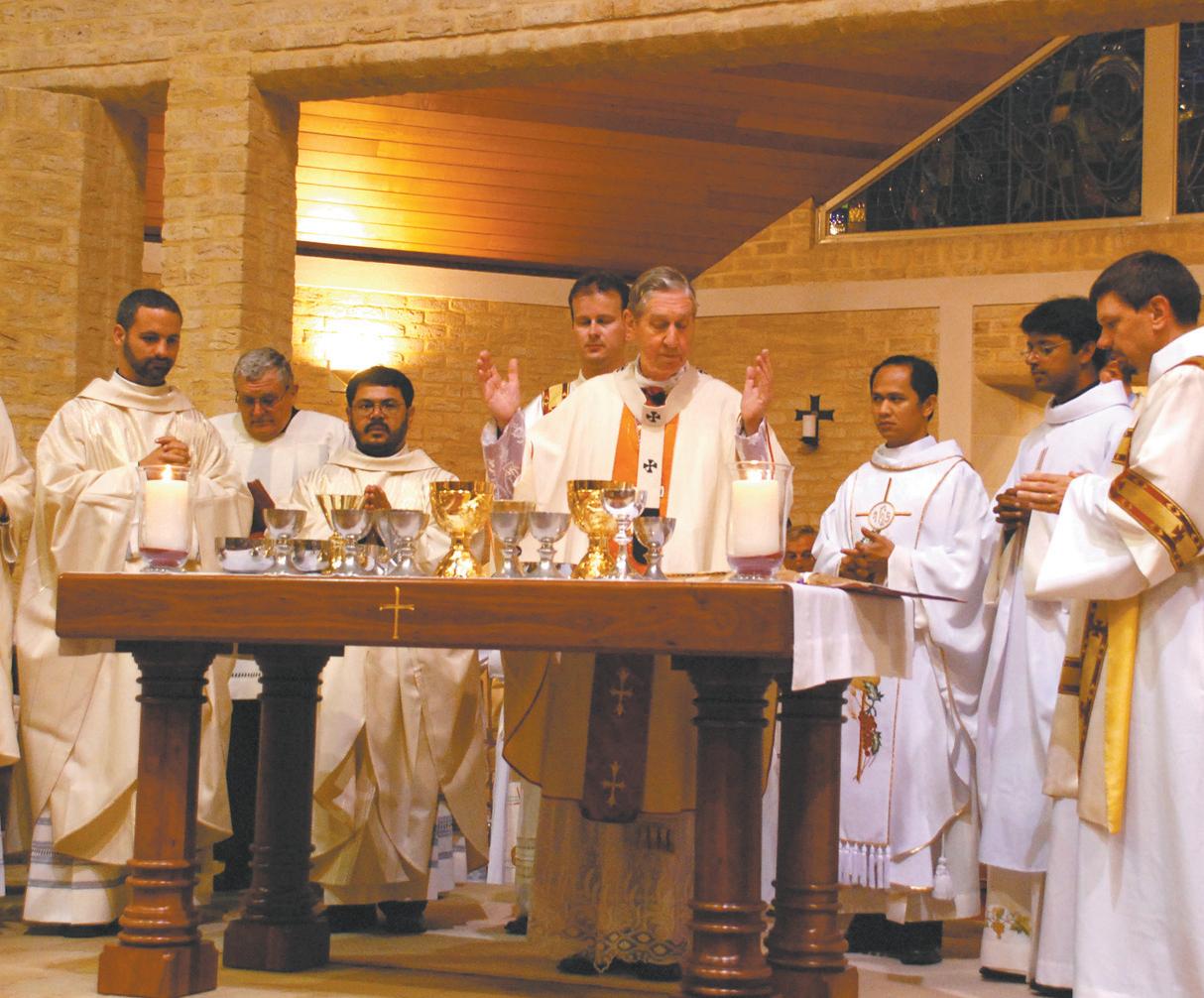 ■ By Matthew Biddle
■ By Matthew Biddle
Two changes to the celebration of Mass will be implemented in all Catholic parishes in Australia on Pentecost Sunday.
The changes are part of the introduction of the new General Instruction of the Roman Missal, which guides the way we celebrate Mass and has been approved by the Holy See.
From May 11, parishioners will be required to stand during the congregation’s prayer during the Preparation of the Gifts.
After the priest says ‘Pray, brethren, that our sacrifice may be acceptable to God the Almighty
Bishop Christopher Saunders says indigenous themes, symbols and colours will be much on display throughout World Youth Day in July.
Bishop Saunders is chairing an indigenous communities advisory committee which is working to ensure the papal visit receives the full blessing of Aboriginal symbolism. The Pope will receive a “welcome to coun-

JOHN
Father,’ the assembly will stand and respond with ‘May the Lord accept the sacrifice at your hands to the praise and glory of His name, for our good, and the good of all His Church.’
At present, the congregation remains seated until the end of this response.
When approaching to receive Holy Communion, parishioners will need to “bow in reverence of the Mystery that they are to receive,” according to the Australian edition of the General Instruction of the Roman Missal.
More changes to the Mass are expected to follow as the new Order of Mass is gradually introduced throughout Australia.
try” by indigenous elders, and all bishops and cardinals – but not the Pope -- will wear vestments featuring indigenous colours and designs.
Sydney Aboriginal community leader Elsie Heiss said World Youth Day will be “a marvelous opportunity to show the indigenous face of the Catholic Church in Australia.”
She said Aboriginal people will “welcome Pope Benedict and the many young Catholics who will come here to celebrate their faith on this land.” The Pope will also be treated to indigenous music and dancing.
Is it true our company philosophy is “We are a friendly and efficient company trading with integrity and determined to give our customers the very best of service?”
Is it true I regularly publish testimonial letters from satisfied customers because of my tremendous reputation for outstanding service?
Is it true I believe that before anyone buys a pre-owned vehicle they should choose their dealer before they choose their car and that dealer should be mine? and...
Is it true I say this, because of my reputation for honesty, fair dealing, huge range of vehicles and non pushy salespeople.
Is it true when people do business with me, I guarantee they will be treated with courtesy, sincerity, professionalism and efficiency?
Is it true that I have over 40 technicians who are dedicated to getting my used cars in first class condition before sale?
Five medical students from The University of Notre Dame Australia’s Fremantle School of Medicine attended the Breathing NEWLIFE into General Practice Conference held at Parliament House, Canberra in March.
Hosted by the General Practice Registrars Australia (GPRA), General Practice Students Network (GPSN), General Practice Education Training (GPET) and Department of Health and Ageing (DoHA), the conference sought to bring stakeholders together with the General Practitioners of the future to engage with current leaders from the industry to develop positive directions for Australian General Practice.
Second year medical student and Notre Dame’s GP Student Executive Officer, General Practice Students Network (GPSN), Jeanita Wong explains:
“The main issue emphasised over the twoday event was the importance of general practice within the national health framework.
Key figures in the health industry were invited to discuss the concerns and targeted solutions to address future workforce shortages, training standards, infrastructure capacity and workforce requirements.
They also addressed other important con-
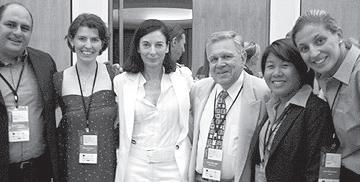
tributions to help foster best practice for the future of Australian General Practice.
Patron of the event, the Hon Nicola Roxon delivered a keynote speech on the first day.

IThe conference was also attended by Senator Bob Brown; Professor John Horvath, DoHA; Associate Professor Simon Willcock and Erich Janssen, GPET; Dr Rosanna Capolingua,
t is not often a school hears from an ex student who is 98 years old.
This happened at Mercedes College recently when Jean Ferguson (nee De Banks) from the class of 1927 invited former principal, Sr. Mollie Wright, and Lyn Barker, a Mercedes teacher and ex student, to lunch at her home recently.
Jean was a boarder in her last year at Our Lady’s College or “The Square” as she remembers it called.
Jean went on to train as a teacher, work in the country, marry and have two children.
Initially she worked as a monitor in primary schools, and then studied at
Australian Medical Association (AMA); Mr Joe Hockey MP and Professor John Murtagh, GPRA Patron.
It was the first time that the General Practice Students Network had attended the conference as the organisation was only formed in 2007 when members of Australian Medical Students’ Association (AMSA) and GPRA met to discuss the current perceptions of General Practice in medical schools.
From this meeting a network was designed that would allow students to take an active role in contributing to the future of Australian General Practice and medical workforce.
GPSN’s mission is to foster a greater awareness of General Practice as both a lifestyle and a career.
It aims to provide a forum by which members can provide feedback on medical student issues relating to General Practice.
They also produce educational and professional resources for medical students to promote General Practice, and seek to work with other key stakeholders such as the State and Federal Governments, GPET, AMA, The Royal Australian College of General Practitioners, Australian College of Rural and Remote Medicine, Divisions of General Practice and Rural Training Providers.
Claremont Teachers’ College and UWA when it was in Irwin Street, in the city. She had to retire from teaching when she married, as married women were not allowed to teach back then. Her memory of her school days is amazing and she told some wonderful stories.
She could describe in detail the colours of the uniform, something hard for school archivists to work out from the old black and white photos of the day.
Better than this though, was her memory of bath nights, where “the girls were meant to wear a shift as they
weren’t allowed to see themselves in the altogether.” Jean laughed that the girls would just take off the shift, wet it and have a “proper bath.” Shakespeare was considered a little racy back then and the girls were made to rule lines through any “rude” bits.
Jean was able to name all but two of her class when looking at a photo of her Leaving and Sub Leaving group.
Although her memories of school were of fun and tennis and lessons in the beautiful limestone Romansleigh building, she also spoke of some sad times when a fellow boarder lost her policeman father in an infamous Kalgoorlie gold stealing case.
Two policemen were murdered by the thieves.
Sr Mollie is originally from Kalgoorlie and had heard her parents talk of this case.
Jean remembers her teachers, the Sisters of Mercy with affection.
She described her former teacher, Sr. M Emmanuel as a strong, vibrant and slightly rebellious woman with glorious red hair, waves of which often escaped to show out of her veil.
Another favourite of Jean’ was Sr. M Loyola.
Jean named Joan Edwards and Amy Pitman as her friends.




After living in several country towns with her husband Alex, a bank manager, and her daughters Jean moved to Subiaco in the early ‘60s.
There are two daugters, Barbara, who lives over east, and Sandy Hoffman, who was at the lunch and whose support has helped Jean retain her independence.
Jean has four grandchildren and is thrilled that a great grandchild is expected in May.
A niece, Lois McAdam, keeps in touch with Jean and came to the lunch. Lois (Lawson) is an ex student of the college, class of ’53. Originally two schools ran at “The Square,” Our Lady’s College and St Joseph’s College which were joined in 1967 to become Mercedes College.
Mercedes College salutes Jean Ferguson who turned 98 on April 3. With her active mind, keen sense of fun and friendly and welcoming attitude, Jean is an example to all of us.
Mercedes welcomes all ex students to keep on touch.
Contact barker@mercedes.wa.edu.au or call Lyn Barker, Community Relations on 93231367
Somewhere in a factory in northern Italy, an Indigenous Australian image of the Holy Spirit is being fashioned onto the back of specially designed World Youth Day chasubles.
The 700 chasubles — the outer garment that covers the celebrant from the neck down — will be worn by Cardinals and Bishops celebrating the opening and final Masses of World Youth Day in Sydney in July.
The image of the Holy Spirit was originally painted by Marjorie Liddy, a Tiwi woman from the Melville Islands in the Northern Territory.
Sr Rosemary Crumlin RSM, a Parramatta Sister of Mercy who lives in Melbourne, told Kairos the story of how the image of ‘Marjorie’s Bird’ came to be.
“One day, Marjorie was fishing in a remote, beautiful area. She stayed longer than she intended. The moon came out and she rang her son to come and pick her up. She looked up and saw a bird in the sky made of stars. Around its head was a gold crown,” Sr Rosemary said.
“Marjorie said to her son: ‘Look up in the sky; what can you see?’ He said: ‘Mum, I can see stars’, but he couldn’t see the bird. She told me that when she saw it, she began to sing.
“She wasn’t a painter so Marjorie went and spoke to a woman she knew at an arts centre and asked her to paint it. When the artist produced the image, Marjorie said: ‘No, that’s not
my bird. That’s not what I saw.’ So she went out and did the only painting of her life.”
The World Youth Day Sydney office created prayer cards last year with the image, entitled ‘The Day the Holy Spirit visited Marjorie and her people’.
Sr Rosemary collaborated with Fr Peter Williams, the WYD08 director of Liturgy and graphic design firm Stuart Pettigrew Design, to design the vestments.
“We want to ensure we reflect our unique landscape, history and cultural influences when the international spotlight is on Sydney for this great event,” Fr Williams said.
To this end, Fr Williams said, the vestments would be an ‘earthy red’ colour to reflect the Australian landscape, and would feature the Southern Cross on the front, signifying Australia as the ‘Great Southern Land of the Holy Spirit’.
“This is reinforced by the indigenous image on the back of the chasuble – Marjorie’s Bird – also representing the Holy Spirit,” he said.
The chasubles are currently being produced in Bergamo, in northern Italy, by Solivari, a company that specialises in liturgical vestments. Sr Rosemary said they had hoped the chasubles would be made in Australia on Australian wool, but the costs and the short time frame proved to be insurmountable. Solivari was able to produce the garments in the short time available.
About 3000 stoles — the strip of cloth worn around the neck that hangs down past the waist — will also be made for priests and deacons to use throughout the WYD08 week.
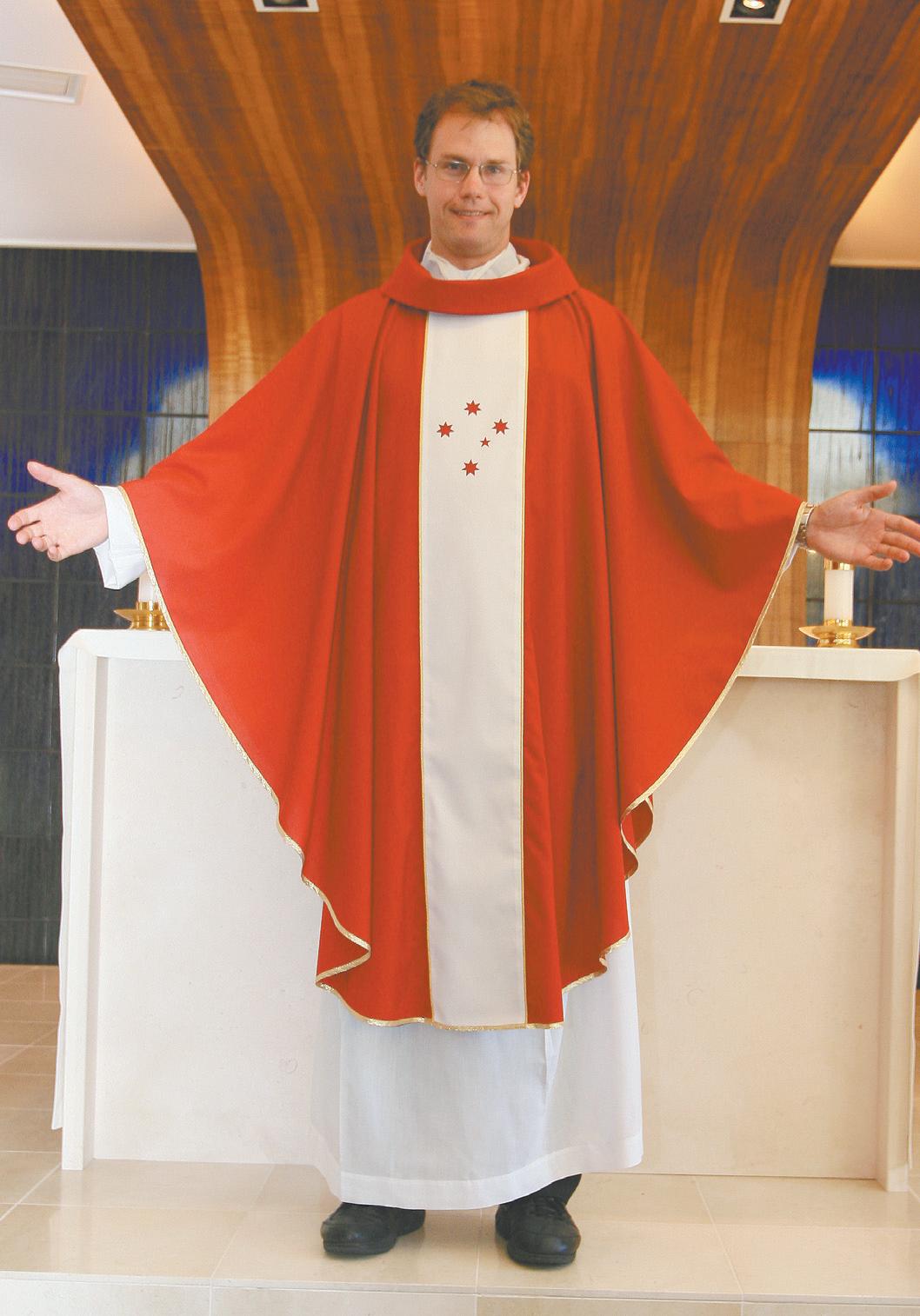
Regal red: Fr Michael de Stoop, WYD Vocations Expo Coordinator (Pastoral content) models the WYD chasuble to be worn by cardinals and Bishops
Inset: Majorie’s Bird is featured on the back of the WYD chasuble
PHOTOS: CATHOLIC WEEKLY
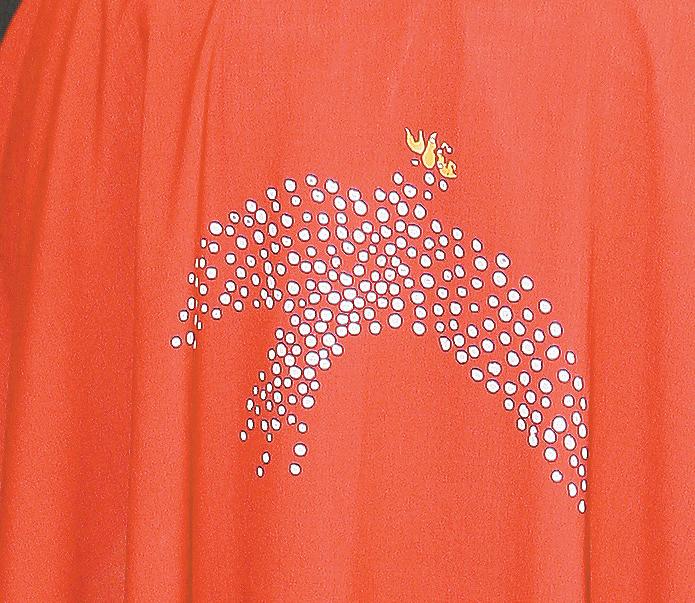


Cof an interactive website and the purchase of a laptop computer, data projector and associ-


Catholic Outreach, an agency of the Archdiocese, offers a broad range of services to parishes to assist them to set up and develop Care Programs.
Catholic Outreach Chairperson, Brian Parry said that the grant for the development of an interactive website would not only be a great benefit to the volunteer Co-Ordinators in the day to day management of their parish care programs but would also be a useful tool to raise the awareness of care programs in communities and to promote the development of new programs in parishes.
“The interactive website will be a great boon to Co-Ordinators who reported in our last survey of parish care programs that they had organised volunteers in over 20 parishes to undertake 10,000 jobs in one year” said Peter Mc Minn Executive Officer of Catholic Outreach.
For further information please contact: Peter Mc Minn Executive Officer Catholic Outreach 9422 7920 or outreach@highgateperthcatholic.org.au
The President of the Australian Catholic Bishops Conference said he was humbled and privileged to be present at Prime Minister Rudd’s 2020 Summit last weekend.
Archbishop Philip Wilson was one of 1000 Australians chosen to attend the Summit. During the meeting he participated in discussions on “Strengthening communities, supporting families and social inclusion.”
Afterwards Archbishop Wilson stated: “Generally, to be there among the thousand delegates was a real honour.
Many participants were aware of the cynicism around the exercise, and were determined to come up with real ideas to put into practice.”
The Archbishop said his section of the Summit produced a vision statement which reflected the importance of human dignity.
The vision statement read: “This stream imagines Australia in 2020 as a diverse and respectful society that provides all people with security and opportunity. Australians should be involved, healthy, safe, educated and housed.”
Archbishop Wilson said he believes his own, Catholic contribution to the Summit’s discussions was reflected in this final statement in some way.
“My presentation started with the principle that every human person has dignity and value in himself or herself. While this was not in the actual statement I know that it has had some influence,” he said.
The Archbishop said the Summit produced practical outcomes as well as statements of principle.
One was a suggested national “micro-credit” system to provide loans to people outside main-
stream financial services, to help them into home ownership.
He said just such a system is working well in Bangladesh. People in his group at the Summit warmly endorsed and recommended the idea as one that could also help poor Australians.
While Archbishop Wilson voiced tactful praise for the Summit, some secular commentators aired a dimmer view.
Writing in the Sydney Morning Herald, columnist Annabel Crabb likened the Summit to a religious event with the Prime Minister as deity.
“Picture Vatican II with Kevin Rudd playing the role of God. That’ll give you a fair idea of what this weekend was like,” Crabb wrote.
She said much like God at Vatican II, the Prime Minister was not technically a participant at the 2020 Summit. “But to pretend that the event was not all about him would be absurd.”
Fellow commentator Paul Sheehan said the conference was a grandiose event where no-one was grappling with the real “cancer” of the times.
Sheehan defined today’s main social sickness as the rising tide of litigation, compulsion, intrusion, a creeping sense of entitlement over obligation and a proliferation of tribunals.
“Australia is becoming a society under the rule of lawyers, not laws,” Sheehan remarked, lamenting the lack of attention paid to this problem at the Summit.
A more positive assessment of the Prime Minister’s role was voiced by the policy director of the Per Capita think tank, Michael Cooney.
Writing in Melbourne’s The Age, Cooney wrote that the 2020 Summit was not a talkfest, but “a real moment of engagement.”
Cooney said Rudd’s Summit seemed to be the beginning of a process of the Government engaging society, not just the state.
to give all participants a practical awareness of the life and work of the Cairns diocese.■
By
Paul GrayThe diocese of Cairns will hold a synod in June to examine the future direction of the Church in northern Queensland.
Nominated members of each parish in the diocese will attend the synod which will be led by Cairns Bishop James Foley.
Members of the clergy, religious communities and lay movements of the diocese will also participate.
The synod is intended to last three to five years, with annual meetings to take place after the initial sessions this June.
Official literature from the Cairns diocese says the synod will maintain and direct the momentum which was built up by a series of workshops around the diocese conducted by Presentation Sister Mary Franzmann in 2007.
It will also give all participants a practical awareness of the life and work of the Cairns diocese. A Passionist priest from Melbourne, Fr Kevin Hennessy, will conduct the synod sessions.
Cairns is Australia’s northernmost diocese, extending from Innisfail, south of Cairns, to Thursday Island off Cape York in the north, and east from the Pacific Coast to the Northern

Territory border. Last week Bishop Foley was unable to respond to questions from The Record concerning the synod due to meetings of the Queensland bishops in Brisbane.
Diocesan synods, though unusual in Australia, are encouraged under the Code of Canon Law 1986.
The law encourages diocesan synods as widely representative and regularly held meetings. Earlier diocesan synods, including two held previously in the Cairns diocese, were attended by clergy only. The earlier Cairns synods were held in the time of Bishop Thomas Cahill (later Archbishop of Canberra-Goulburn) who was Bishop of Cairns from 1948-67.
The 2008 Cairns diocese synod comes about after a series of workshops held around the Cairns diocese, and following a diocesan “strategic review,” both conducted last year.
The workshops were conducted by the leader of the Presentation Sisters in Queensland, Sr Mary Franzmann. Sr Franzmann has conducted similar reviews for other dioceses.
Throughout the synod sessions a book of the Gospels will be prominently placed and opened, which for centuries has been the standard practice for General Councils of the Church. The symbolism is to indicate that all decisions made by
the meeting should be “challenged in the light of the Gospel,” Bishop Foley said in a 2007 pastoral letter announcing the synod.
The bishop said a synod is not a talkfest but a “prayerful, formal and serious” meeting of God’s people.
In his pastoral letter, Bishop Foley foreshadowed the idea that an annual synod would be an opportunity for the bishop to give an account of his own stewardship and ministry in the diocese.
It would also be a practical meeting where a reconciling could be made of “unlimited pastoral demands with the limited personal and financial resources available.”
In a 2007 pastoral letter announcing the synod, Bishop Foley cited the gospel story of Mary and Martha, and in particular Jesus’ words about worrying and fretting over problems.
The bishop said that the workshops conducted by Sr Franzmann showed that there has been some worrying going on within the Cairns diocese.
“It was evident at each meeting I attended that everybody who came had already reached that stage of worry about what we were doing and where we are going as this local Church.” Yet few people were fretting, Bishop Foley wrote.
The bishop listed a number of positive initiatives that had occurred within the Church in northern Queensland in recent years, including a program to prepare pastoral carers for hospital and aged care work, four men committing themselves to train as deacons for the diocese and the ongoing success of Catholic schools.
By
Paul GrayA new DVD for school and church use tells the story of a 16year old girl who “fought the system” to be allowed to have her baby.
Australian author and speaker Bernadette Black is interviewed on the DVD, LifeMatters Vol 1, in which she narrates her experiences after falling pregnant in her final year at school.
Typifying the pressures that can lead young women to choose abortion, Black found she had to ask for help so that she could keep the baby.
One form of help she had to fight for was an exemption to let her finish her final studies. The school she was attending could not assist her, so Black had to write letters and lobby to receive a special exemption.

Her school and family supported her in her pregnancy, but she felt vulnerable because of how she was looked at. “I kept my head down so I wouldn’t have to look at anyone’s prying eyes,” she said. “I knew inside that I was going to try and be the best mum and I wanted to wear a sign saying ‘This girl’s going to try and be a good mum’.” But she felt that such a sign would have little difference to how people regarded her.
resource that would be of genuine use to young women facing this particularly difficult situation.
“We felt that it is really time to give young women more real choices than ending the pregnancy – a decision that is often taken under enormous stress, pressure and with little awareness of the long term impact.”
Through the Life Matters DVD, a key message Bernadette Black communicates to young pregnant women is that you need to get people around you who can support you, and you have to ask for help, says Mr Doyle.
Choicez Media is a company set up by husband-and-wife team Jonathon and Karen Doyle, who have done extensive work around Australia in recent years delivering values-based sex education programs.
Thursday
Friday
Jonathon Doyle, Managing Director of Canberra-based media company Choicez Media, says the company’s aim in producing this DVD was to avoid polemics, and focus instead on young women.
Mr Doyle told The Record that debate in the pro-life area is shifting on to the theme of outcomes for young women. Understanding their psychological state is crucial for successfully communicating a prolife message, he says. “For a long time we have wanted to develop a
Pregnant young women need support, and can easily feel overwhelmed by the practical difficulties of continuing their day-to-day lives, such as completing school, says Mr Doyle. He says Bernadette Black is a “very special person” whose story can help young women address the “sense of powerlessness” that they feel in this situation.
Bernadette Black, who is now the mother of three children and author of the book Brave Little Bear, revealed on ABC radio in 2006 that when she fell pregnant, she was in Year 10 at a Catholic school.
Through Choicez Media, they are now providing digital education resources to hundreds of schools around the country.
The Life Matters Volume 1 DVD includes a teaching segment on the psychology and decision-making processes of young women, and a music segment featuring a song called “Braver than you think you are.”
Mr Doyle says the Life Matters Volume 1 is the first in a series of life-focused DVD resources that will cover core bioethical issues. A promotional video for the DVD can be viewed at www.choicez.com.au
The Australian bishops have spoken out strongly on the separate roles parents and Governments should play in combating the dangers of the internet, in a pastoral letter released this weekend.
Christian families should be discussing the dangers of the internet as well as talking with each other about the wider issue of pornography and the damaging impact it has on human dignity and human relationships, the bishops say.
And they urge the Federal Government to quickly implement its declared policy of requiring ISPs – internet service providers – to filter out pornographic and violent content.
“Any parent with even an elementary knowledge of the internet knows that there is the everpresent danger of their children being exposed to dangerous material,” the bishops say in their pastoral letter on “Internet Safety,” finalized for publication this week.
The pastoral letter is timed for release on World Communications Sunday, which is this weekend.
Pornographic, violent or offensive internet material can be inadvertently discovered by chil-

dren, the bishops warn. The dangers are such that governments are morally justified in taking tough action to restrict them.
“Civil authorities should prevent the production and distribution of pornographic materials, and that includes, as far as possible, distribution on the internet,” the bishops say
Paying heed to the political debate over whether compulsory ISP filtering is feasible, the Australian bishops argue that on balance, it is a move in the right direction. “While such filtering may never screen out all of the websites in
question, it is operating successfully in other countries and is a major step forward in protecting the community from unwanted material on computer screens,” they write.
“We pray that ISP filtering will be a reality in the near future.”
The bishops warn against dangers to children and adults alike which arise from the internet.
The ready availability of pornography is “one of the most evil uses of the Internet,” they say. Its private nature means there is a real danger of addiction for adults.
The bishops say internet pornography undermines the intimate giving of spouses to each other in marriage, and injures the dignity of its participants.
“It immerses all who are involved in the illusion of a fantasy world.”
The bishops also draw attention to the dangers of pedophiles preying on children through the internet, and encourage parents to educate their children about internet safety, including the need to never give out personal information while online.
The pastoral letter quotes from the teachings of Pope John Paul II who said the internet, like the new frontiers of other times, “is full of the interplay of danger and promise.”
The Director of Catholic Education in Victoria has reiterated the Church’s firm opposition to relinquishing control of Catholic schools to Governments – despite welcoming measures to improve the resources of Catholic schools.
Last week secular media outlets reported that the Victorian Government was examining a radical plan to align Catholic schools with the state system.
The Victorian Minister for Education, Bronwyn Pike, praised moves in New Zealand where, she said, “the Catholic system has come much closer to the state system.”
Ms Pike said there are opportunities for “partnerships” which she would like to explore with the Catholic system, and said Catholic schools in poorer areas were facing many of the same issues as state schools.
Responding to the Minister’s comments, Victoria’s Director of Catholic Education, Stephen Elder, told The Record that initiatives by the State Government to improve Catholic school resources would be viewed gratefully.
“Currently for every dollar that the government spends on schooling, Catholic schools receive 16 cents,” Mr Elder said.
He said any improvement in the funding and resourcing of Catholic schools, particularly those schools in low socio-economic areas,
would be very beneficial to the Catholic system.
However, control over the Catholic school system was a different matter, Mr Elder said.
“The issue of control of our system is a separate issue from resourcing, and certainly any attempt to limit our autonomy in matters of faith education as a trade off for resources would not be accepted.
“Our identity as Catholic schools and the determination to have schools that are places for Catholic families to be nurtured in their faith will never be compromised.”
Mr Elder said new government initiatives would require consultation with the key stakeholders within Catholic education
Caritas Australia expressed grief over the murder of a priest in Sri Lanka.
Sri Lankan priest Fr MX Karunaratnam, who was head of the North East Secretariat on Human Rights, was killed by a roadside bomb which AP news agency said was set by Government soldiers.
Acting CEO of Caritas Australia, Jamie Isbister said more than 3000 have died in Sri Lanka since the collapse of a ceasefire in January. “The culture of impunity that is operating in Sri Lanka needs to be urgently addressed, as virtually none of the killings, abductions and human rights abuses that continue to occur in Sri Lanka are ever brought before the courts.”
The public push for legalized euthanasia shows no sign of slowing down – and a $5million bequest to the euthanasia cause gives it more steam still.
The former Lord Mayor of Brisbane, Clem Jones, who died in December, left $5million to fund a campaign to promote legalized euthanasia.
Meanwhile pro-euthanasia activists are stirring the pot nationally with two private members’ bills promoting the cause in two different legislative settings: the federal parliament, where Greens Senator Bob Brown has a bill being examined by a Senate committee, and Victoria where a private member’s bill is likely to be introduced this year to the state’s parliament.


Mothering is an awesome, taxing and rewarding job. In this book, Anna Melchior seeks to help mothers in their hugely important role by providing spiritual insight drawn from her Christian faith and practical advice.
$24.95+postage


Praying is one of the most vital things we can do for our kids. Julie Cragon provides prayers for every stage of a child’s growth, beginning even before they are born and going all the way to the point when they are becoming mums or dads themselves.
$21.95+postage


When dirty dishes and laundry start to pile up, it’s easy for Catholic mothers to believe that the call to sanctity is for someone else. In this book, Donna-Marie draws from her own life as a mother to five children, and from the teachings of Mother Teresa on home, family life and prayer.
$27.95+postage


Transform the traditional nine-day prayer of preparation for the feast days into a nine-month devotional practice for your pregnancy with this keepsake prayer journal. The book offers a place for expecting mothers to celebrate the mystery of pregnancy in prayer and reflection.
$29.95+postage

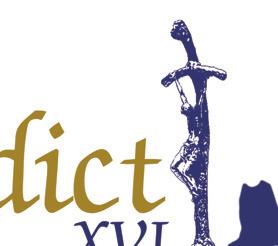



As the Pope toured the US over the last week there was one topic he kept returning to.
■ By John ThavisOn his first trip to the United States, Pope Benedict XVI achieved three objectives that could be considered critical to the pastoral future of the American church.
First, the Pope brought a certain closure to the priestly sex abuse scandal that has shaken the church for more than six years, expressing his personal shame at what happened and praying with the victims.
Second, he set forth a moral challenge to the wider US culture on issues ranging from economic justice to abortion, but without coming across as doctrinaire or bullying.
Third, to a church that often seems divided into conservative and liberal camps, he issued a firm appeal to “set aside all anger” and unite in order to effectively evangelise society.
In the process of his April 15-20 visit, the 81-year-old Pope established his own identity in a country that did not know him well and in a sense came out of the shadow of the late Pope John Paul II.
“I feel like I know him a lot better. I learned that he is trying all his best to reach out to the youth,” 18-year-old Gabriella Fiorentino of New York, said at a youth rally on April 19.
Did she understand what the Pope, a scholarly theologian, was trying to get across?
“Jesus’s message of hope - that is his message,” she said.
The Pope addressed clerical sex abuse on five different occasions, beginning with his encounter with reporters aboard his plane from Rome. He spoke from the heart about the shame, the damage to the church and the suffering of the victims.
He also spoke with familiarity about the church’s efforts to make sure perpetrators are out of ministry and to implement better screening of would-be priests.
At one point, he mentioned that when he read the case histories of the victims, he found it hard to imagine how a priest could betray his mission to be an agent of God’s love.
These were far more detailed and direct comments on the issue than were ever made by Pope John Paul, and there was a reason: As Cardinal Joseph Ratzinger, Pope Benedict
headed the doctrinal congregation, which took over the handling of sex abuse cases in 2001.
What Cardinal Ratzinger saw in those files led him to denounce, in early 2005, the “filth” inside the church - even among its own priests.
The Pope’s unscheduled meeting with five sex abuse victims was a moving and tearful encounter. It seemed to mark an emotional turning point for several of those who participated and perhaps indirectly to others among the thousands of victims in the United States.
Overall, the Pope left the strong impression among Americans that, on the sex abuse issue, he “gets it.”
The Pope’s broader issue in the United States was what he called the “attack of a new secularism” that threatens to undermine traditional moral values and the voice of religion
church’s message of hope and fidelity to the demands of the Gospel.
What was striking about the pope’s approach was that it was framed in a very positive context. Over and over, he praised the United States for blending a secular form of government with a moral order based on “the dominion of God the Creator.”
He quoted George Washington, who called religion and morality the “indispensable supports” of political prosperity, and cited Franklin Roosevelt’s statement that “no greater thing could come to our land today than a revival of the spirit of faith.”
The pope warned, however, that today this secular-moral balance risks tipping toward a godless, individualist form of freedom. He made his argument more relevant by linking it to a popular contemporary issue: environmental degradation. “The earth itself groans

in public affairs. He articulated this challenge on several occasions, most notably telling 45,000 people at a Washington Mass that American society is at a moral crossroads.
“We see clear signs of a disturbing breakdown in the very foundations of society: signs of alienation, anger and polarisation on the part of many of our contemporaries; increased violence; a weakening of the moral sense; a coarsening of social relations; and a growing forgetfulness of God,” he said. To counter these trends, he said, people need the
under the weight of consumerist greed and irresponsible exploitation,” he told young people. In the Pope’s view, ecology is part of an ethic of respect for creation and the creator.
When it came to the Church and its sometimes divided membership, the Pope had an equally encouraging approach. Time and again, he praised the vitality of parish life and movements and noted US Catholics’ continuing contribution to the life of the country. He said he was convinced that God was prepar-
ing a “new springtime” for the church in the United States.
The Pope looked honestly at shortcomings, too, lamenting that some Catholics are not in line with Church teaching, even on the issue of abortion. But his solution, expressed to bishops, was a long-term program of religious education, not a set of short-term marching orders or penalties.
In a comment aimed at people inside and outside the Church, he said the faith is more than a set of rules and suggested that more attention should be given to external challenges.
“Perhaps we have lost sight of this: In a society where the Church seems legalistic and ‘institutional’ to many people, our most urgent challenge is to communicate the joy born of faith and the experience of God’s love,” he said.
One of his strongest themes was Church unity. At a Mass in St. Patrick’s Cathedral in New York, he expressed disappointment with the formation of divisions within the Church between Catholic groups, generations and individuals. The Church, he said, needs to “put aside all anger and contention” and turn its gaze together toward Christ.
At a Mass in Yankee Stadium on his last day in New York, he told Catholics to remember that all Church groups, associations and programs exist only to support and foster deeper unity in Christ.
The papal Masses highlighted the diversity of the Church in the United States which, as the Pope said, comes together in a “common commitment to the spread of the Gospel.” These were colourful, musical liturgies and the Pope seemed pleased with them.
The papal visit did not register very high on topical issues. He avoided partisan political questions, did not mention Iraq and, although he visited ground zero, certainly did not dwell on terrorism.
His United Nations address was not a stateof-the-world survey but a call to conscience on the moral foundations of human rights.
The Pope’s focus was religion and its place in all areas of life.
Before the papal visit, most Americans said they didn’t know a lot about Pope Benedict. When he left the country, they were more likely to view him as he described himself upon his arrival: as “a friend, a preacher of the Gospel and one with great respect for this vast pluralistic society.” CNS Pope urges re-evangelisation - Page 10
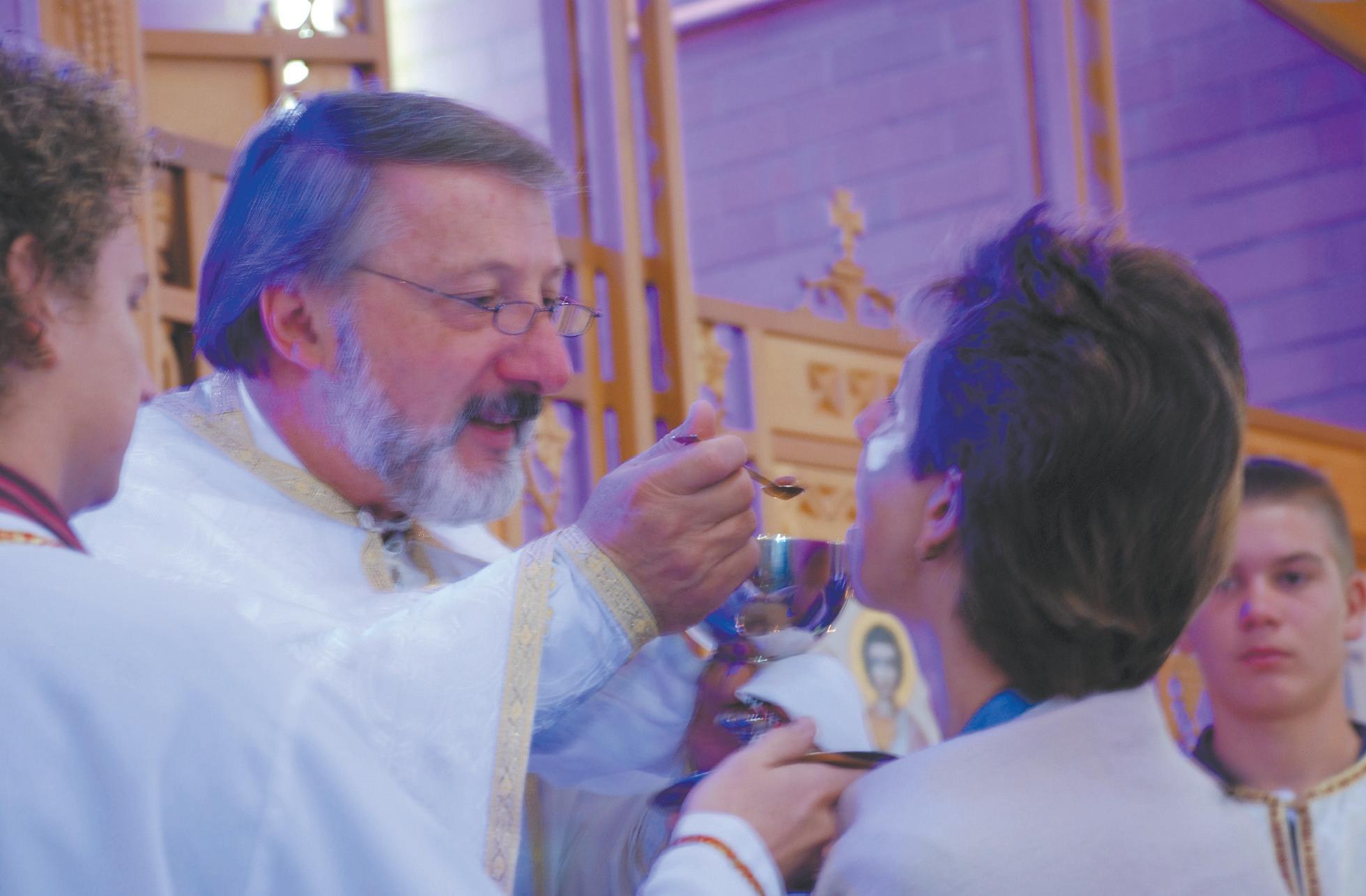
About 150 members of Perth’s Ukrainian Catholic community celebrated Palm Sunday last week at St John the Baptist church in Maylands.
Fr Wolodymyr Kalinecki celebrated Mass according to the Byzantine Rite and said he was pleased with the turnout. “I’m just glad that so many people came, I was a bit worried that maybe not too many would come, but the church was quite full,” he said.
The traditional Blessing of the Palms followed the Mass, which is commonly referred to in the Ukrainian Church as the Divine Liturgy.
Fr Kalinecki explained why the Eastern Catholics celebrate Palm Sunday and Easter almost a month later than Western Catholics this year. “We celebrate according to the Julian calendar – a calendar that was followed by all
the churches early in the centuries,” he said. “When the Gregorian calendar came along, which was more accurate, it was adopted by many other churches, but the Ukrainian church stayed with the Julian calendar basically to preserve their identity.”
After Mass, the parish held its annual fete, providing a chance for parishioners to enjoy each other’s company over a hearty Ukrainian lunch.
Fr Kalinecki said the fete was also a chance for parishioners to purchase some special Easter foods, such as paska (a traditional Ukrainian Easter bread) and pysankas (Ukrainian Easter eggs decorated using beeswax).
The Ukrainian Catholic community has been present in Perth for almost 60 years, although the Maylands parish was not established until 1966.
In 1975, a second Ukrainian Catholic church was built, the Church of the Nativity of the Blessed Virgin in Northam.

Fr Kalinecki, who has been parish priest at Maylands since 1996, said that strong numbers attend Mass each week. “It’s very well attended, the youth are not as attentive as they used to be, but its very popular with our own people
… the elderly appreciate it very much,” he said. “It’s still in the hearts of many people, it’s something that helps them identify with their roots.”

There are a number of differences between the Roman Rite of Mass and the Byzantine Rite, although both are legitimate forms of the Catholic Mass.
Fr Kalinecki said while the Roman Catholic Church emphasises Christ’s death for the salvation of many, the Ukrainian Catholic Church emphasises Christ’s resurrection.
Additionally, the liturgy of the Byzantine Rite is based on singing and praising the Lord. “The Byzantine Rite was developed in the East, but obviously the sacraments are the same as in any Catholic Church,” he said.
“The way of worship relies on things like music, singing and poetry, which are very traditional in the East.”
The distribution of Holy Communion is also slightly different in the Byzantine Rite.
“Communion is pieces of bread cut into little cuboids, and they are soaked in wine, and of course during consecration they become the Body and Blood of our Lord,” Fr Kalinecki explained.
Occasionally a Byzantine Rite priest may also be married, as both single and married men are welcomed to the priesthood.
However, once priests are ordained they may not marry, nor can married priests
become bishops. In the Byzantine Rite, the congregation often stand for the majority of the Mass.
“During Easter, the people kneel for all the services while during the rest of the year the people stand during most of the liturgy,” Fr Kalinecki said.
“We also have our special service with prostrations, where there’s about 300 times when we bow to the floor during the Lenten period.”
Eastern Catholics, who are in full communion with Rome, are now developing their own Catechism.
“We are following the advice of the late Pope John Paul II that all churches return to their own traditions,” Fr Kalinecki said.
“Our catechism is based on the Eastern traditions, but of course it has the same teachings as any Catholic church.”
While acknowledging there are differences, Fr Kalinecki said the Eastern and Western churches complement each other well.
“We both appreciate each other’s contribution,” he said.
“When they combined together, which they did in many of the ecumenical councils, they were able to defeat many heresies.”

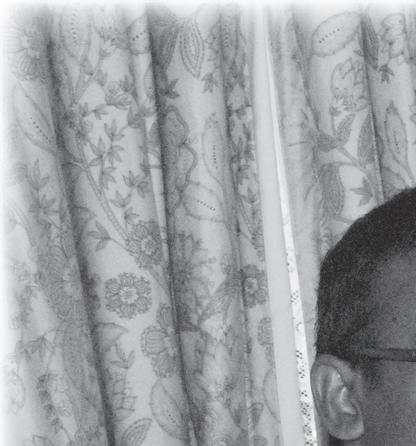
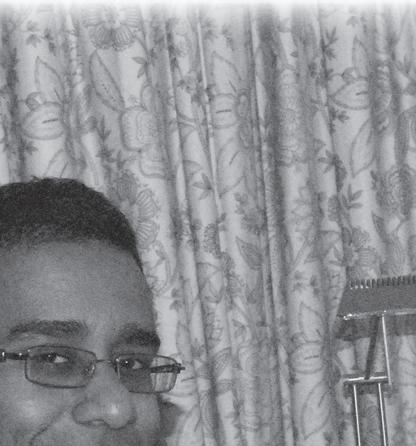





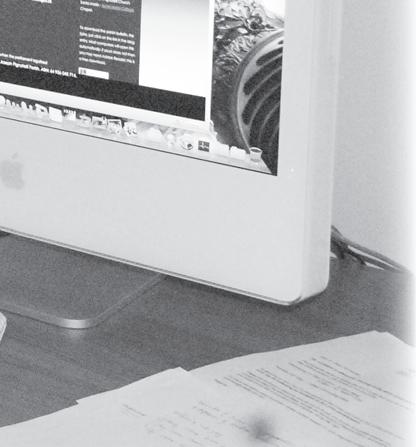

 ■ By Matthew Biddle
■ By Matthew Biddle
TWENTYFIVE parishes in the Archdiocese of Perth have embraced the online revolution and built eyecatching and informative websites.
The websites vary in design from simple to elaborate, but the one goal of all the websites is to inform people about the parish. Common to all parish websites are basic contact details and weekly Mass times. In addition, the majority of websites allow online access to the parish’s weekly bulletin, as well as details of parish groups, upcoming events and access to parish rosters.
A number of websites have also included a detailed account of the parish history, and some include photo galleries of parish events.
Several parish websites are run by parish priests, such as the Riverton and Attadale websites.
Father Jude D’Rozario, who took over as parish priest of Riverton in 2003, said he always wanted to build a website for the parish. “I did a bit of a study on the other parish websites ... I felt most of their material was not current – two or three years old,” he said.
“I wasn’t really that qualified so I had been asking for some help, because there were a lot of things to be learnt.”
On August 5, 2006 the parish website was set-up with the help of Niko Malkiewycz, a teacher at Ursula Frayne College. “I showed him the plan and we worked on it together, and finally he gave me a skeleton to put it up,” Fr Jude explained.
“Then I went on my own, designing, re-designing and updating.”
Attadale parish priest Fr Sean Fernandez is one who knows well the importance of the Internet to communication in today’s world.
The 23-year-old is a part of the computer generation and has grown up using computers for a variety of purposes. He said he wanted the parish to have an active presence on the web.
“The parish had an old website which hadn’t been updated for a while and I decided it would be important to work on it as everyone is on the web these days,” he said. “I think the website provides another
Armadale: www.sfxarmadale.org.au
Applecross: www.stbenedicts.net.au
Attadale: www.attadale.org
Balcatta: www.stlawrence.org.au
Ballajura: www.marymackillop.net
Bateman: www.batemancatholic.org
Claremont: www.claremontcatholic.org.au
Floreat: www.wemflo.org
Fremantle: www.fremantlestpatricks.com.au
Gosnells: www.gosnellsparish.org.au
Greenmount: www.stanthonys.org.au
Greenwood: www.allsaintsgreenwoodwa.org.au
Joondanna: www.users.bigpond.com/gkeenan
Leederville: www.stmarysleederville.com


Maddington: www.holyfamilycatholic.org.au
Manning: www.stpiusx.com.au
Morley: www.infantjesusparish.org.au
Mount Lawley: www.members.iinet.net. au/~stpaulsmtl/index.html
Osborne Park: www.stkierans-osbornepark.org.
au
Port Kennedy: www.st-bernadettes.com
Riverton: www.queenofapostleschurch.org.au
Rockingham: www.ololrockingham.org.au
Subiaco: www.stjosephssubiaco.org.au
Whitfords: www.members.optusnet.com. au/~whitford/index.htm
Willetton: www.johnpaulwilletton.org.au



avenue for getting our message out.” The Attadale parish website has a unique feature – a page where visitors can make their prayer petitions for publication on the website. Fr Sean has also created a blog (an online diary, journal or commentary page), which he continually updates to inform web-users of parish news and activities.
He said he enjoys working on the parish website and sees the internet as a vital tool for parish communication. “People are getting their news and information through the web these days; we need to be out there,” he said.
Fr Sean said he was happy with the design of his parish website. “I must confess to being somewhat pleased with the end result,” he said.
Every parish should try to create its own website, even if it is fairly simple, according to Fr Sean.
“There are generally people in the parish who work with computers and the web – one can draw on their expertise,” he said. “Once the site is up and running, it is easy to update.”
Fr Jude agreed, saying: “I use Microsoft Publisher, it is not at all complicated and any person who is well versed on using Microsoft Word can operate it.”
Fr Sean’s advice to potential website producers is to use some flair in the site’s design but retain ease of use.
“Layout is important - making a site attractive, easy to navigate and convenient to use. If a site is awkward people go elsewhere,” he said.

Although there are seve who have taken on the p sites are created and update
One such volunteer is G of the Joondanna parish we
Mr Keenan, who update said the job has involved a real challenge.
“I keep going because I b mechanism for the parish t
“But it is frustrating to n to interest all those people i money into developing a fir
Mr Keenan set up the we than most other parishes. the software improving day opportunity to bring St De logical age,” he said.
The 76-year-old said th communication tool in tod “With an ever increasin savvy a website and emai with golden opportunities t in a personal and immediat
Mr Keenan has based hi it is still informative and u impressed with other par
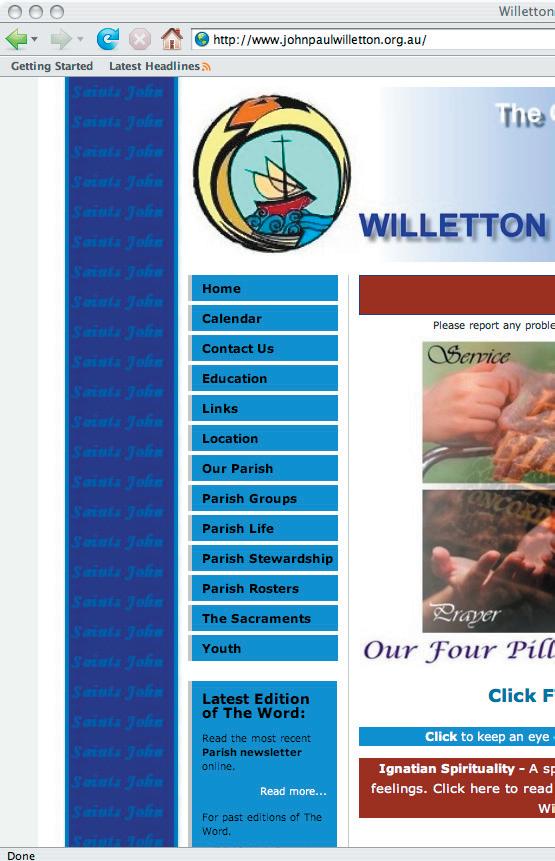





THE STANDARD
eral priests in the diocese arish website duties, most ed by dedicated volunteers.
George Keenan, webmaster ebsite for almost 10 years.
es the website from home, a lot of patience and was a believe it could be a support team,” he said. not have the get up and go nto putting time, effort and rst-class website.”
ebsite in 1999, much earlier “With the technology and y by day it seemed a great enis Parish into the technohe Internet was the perfect day’s world. ng number becoming web l provide the parish team to reach out to parishioners te manner,” he said. s website on simplicity, but up-to-date. He said he was rish websites. “Some have

made me jealous - so well put together and, it would appear, so well used and supported,” he said.
But the Joondanna site can be improved according to its webmaster.
“The website does not attract many visitors or responses for contributions, but I feel certain we could change this with a few dollars spent on a dedicated domain name and some well placed words in the weekly bulletin,” Mr Keenan said.
One parish which has invested in a domain name and promoted its website within the parish is Willetton.
The parish has reached into its pocket and purchased a domain name, and the parish priests remind parishioners of the site at every Mass.
This has paid off handsomely, with the attractive yet user-friendly site proving popular with parishioners.
It has been accessed almost 12,000 times in the past 10 months.
Webmaster Simon Bowen said the site’s promotion, as well as access to parishioner registration and planned giving forms, had led to some fantastic results.
“More and more we get comments from people saying how easy it is to use, how useful it is,” he said.
Mr Bowen re-built the parish website from scratch almost two years ago after discovering it was badly out-of-date.
“We had some pages up on the site, but in 2006 the most recent copy of our parish newsletter was from
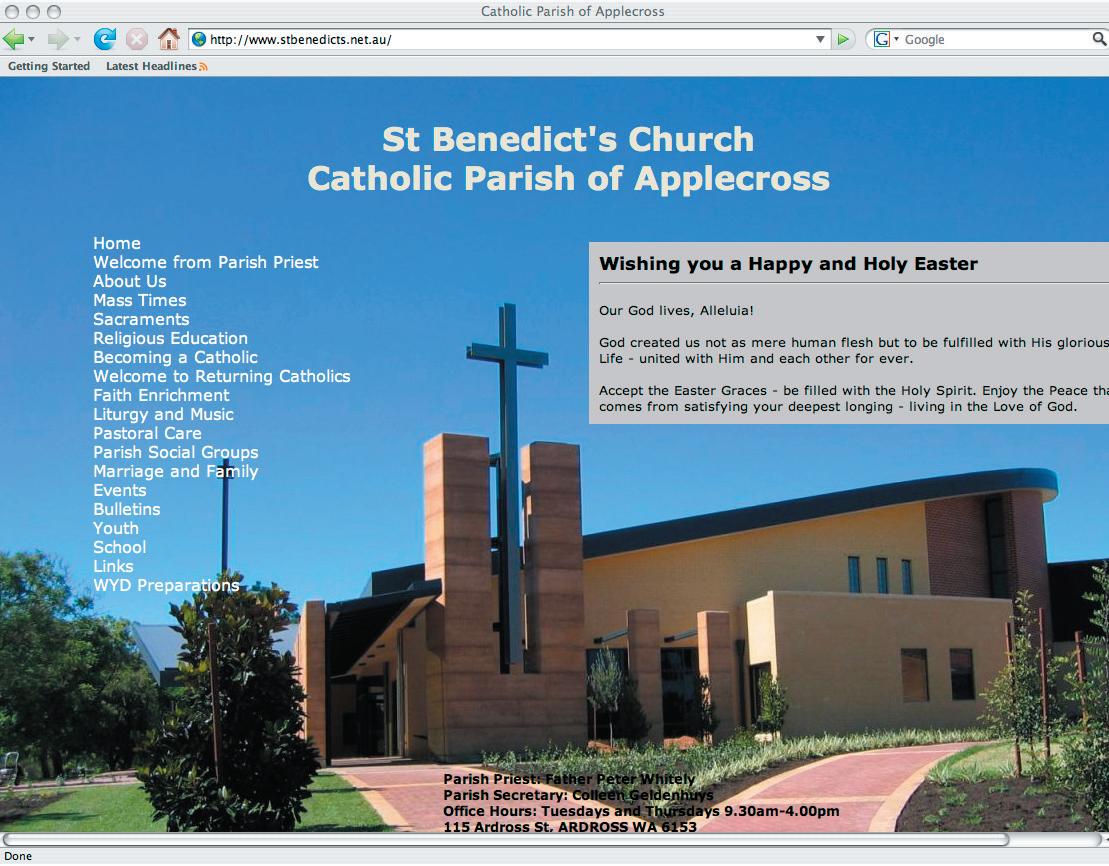


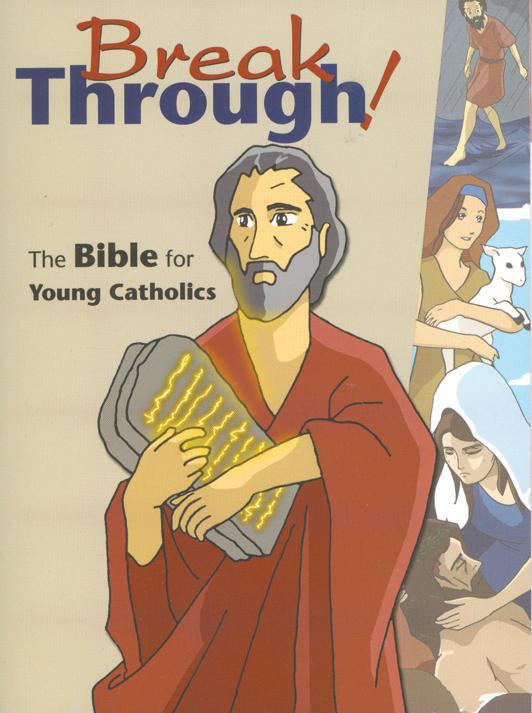
Volunteering his time: 84-year-old Armadale parishioner Don Nield has worked tirelesslytocreateaparishwebsiteandmaintainitoverthepastfouryears.

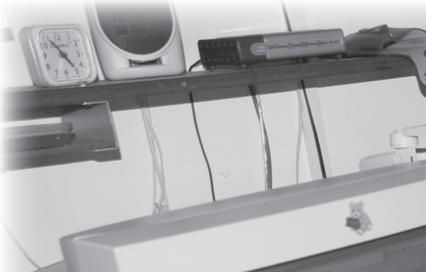





2002 ... and I was concerned about that,” he said. The initial construction of the new website took Mr Bowen about 40 hours of work over two weeks.
One of his main priorities is updating the site on a regular basis.
“People have to be able to trust that it’s up-to-date ... otherwise people don’t come back,” he said.
“I am very pleased with how it’s turned out, I know the parish priests and the parish are ecstatic.”
He said anyone with basic computer knowledge can create a solid parish website.
“It’s not as hard as people think ... if you got a 15year-old kid in the parish with computer skills they’d probably jump all over mine,” he said.
Although all volunteers are special, there is one man who is doing exceptionally well to run his parish’s website.
Armadale’s Don Nield has been battling lung cancer for more than a year yet continues to do as much as he possibly can for his parish.
With no computer experience, Mr Nield said it was tough work when he set out to create a website four years ago.
“I learnt the hard way – I learnt by mistakes, by trial and error,” he said.
Despite his struggling health, the 84-year-old said he enjoyed working on the website.
“Because I’m battling cancer I can’t do anything physical, so I have to keep the brain working and this


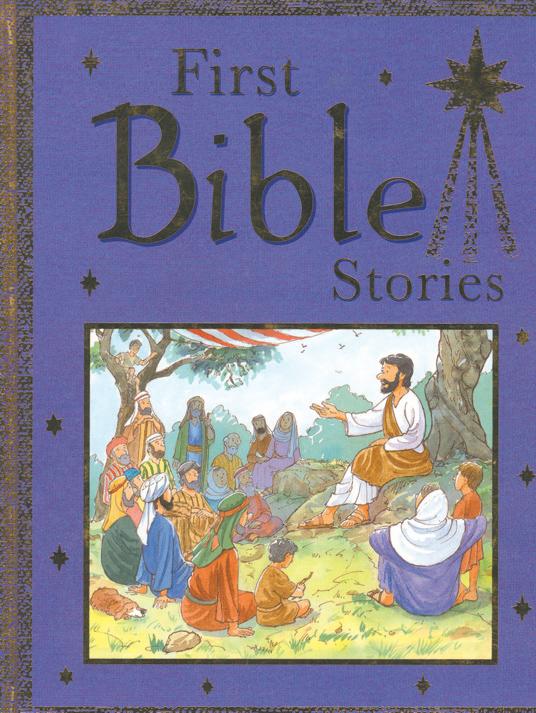






is a way of doing it,” he said.
Mr Nield said he was happy to be contributing to his parish, but added it could be his final contribution due to his ill health.
On World Communications Day in 2002, Pope John Paul II produced a message specifically addressing the use of the Internet.
His message included the following:
“For the Church the new world of cyberspace is a summons to the great adventure of using its potential to proclaim the Gospel message. This challenge is at the heart of what it means at the beginning of the millennium to follow the Lord’s command to “put out into the deep” (Lk 5:4).
“The Internet can offer magnificent opportunities for evangelisation if used with competence and a clear awareness of its strengths and weaknesses.”
“Above all, by providing information and stirring interest it makes possible an initial encounter with the Christian message, especially among the young who increasingly turn to the world of cyberspace as a window on the world.”
“Therefore, on this World Communications Day, I dare to summon the whole Church bravely to cross this new threshold, to put out into the deep of the Net, so that now as in the past the great engagement of the Gospel and culture may show to the world “the glory of God on the face of Christ” (2 Cor 4:6). May the Lord bless all those who work for this aim.”
World Communications Day for 2008 will be on Sunday, April 27.

 By Fr John Flader
By Fr John Flader
In marriage where one partner is a practising Catholic and the other a non-Christian, what requirements are there for the Church to allow the marriage to proceed? Can the couple have a nuptial Mass?
Amarriage between a Catholic and a nonChristian is known as a marriage with “disparity of cult”. The requirements are almost the same as those for a marriage between a Catholic and a baptised non-Catholic Christian, known as a marriage of “mixed religion”.
When a Catholic marries a non-Christian, the couple need to obtain a dispensation from the impediment of “disparity of cult” from the bishop. Without this dispensation the marriage will not be valid.
When a Catholic marries a baptised Christian, they simply need to obtain permission for the marriage, but the marriage will be valid even if they do not have this permission.
It is assumed of course that they will be married before a priest or deacon and two witnesses. In many dioceses, the priest performing the wedding can grant this permission.
In both cases, the couple must satisfy certain requirements for the Church to allow them to marry. These conditions are found in the Code of Canon Law, Canon 1125.
Firstly, the Catholic must declare that he or she is prepared to remove dangers of defecting from the faith, and is to make a sincere promise to do all in his or her power in order that all the children be baptised and brought up in the Catholic Church.
Naturally, if the marriage represented a grave danger to the Catholic party’s faith, the Church could not allow the marriage to go ahead.
Also, it should be noted that the Catholic does not need to promise to bring up the children in the Catholic faith, but only to do “all in his or her power” to bring them up as Catholics.
The Church knows that there are some circumstances in which the Catholic will simply not be able to bring up the children as Catholics.
This is the situation especially in some cultures when it is the husband that is the non-Catholic and he has the authority to determine how the children are to be raised.
Out of respect for the Catholic’s right to marry in these circumstances, the Church only asks the Catholic to be prepared to do all in their power to bring up the children in the faith.
If the Church were to refuse permission for Catholics to marry non-Catholics when it was foreseen that the children would not be brought up as Catholics, it would unduly restrict Catholics’ right to marry.
This is especially the case in some countries where there are very few Catholics and, if they want to marry, they often have no choice but to marry a nonCatholic.
Secondly, the non-Catholic is to be informed of these promises of the Catholic so that it is certain that he or she is truly aware of the promise and of the obligations of the Catholic.
Formerly, the non-Catholic too had to promise to bring up the children as Catholics, but this was seen to be a violation of their freedom of conscience, so the Church no longer requires this promise.
Thirdly, both parties are to be instructed about the purposes and essential properties of marriage, which are not to be excluded by either party. This too, is only natural, since if either party excluded an essential property – for example, indissolubility, openness to life or fidelity – the marriage would be invalid.
Provided these three conditions are met, the Church will allow the parties to marry.
As regards a nuptial Mass, in the case of a Catholic marrying a baptised Christian, the Rite of Marriage suggests that the marriage be celebrated outside Mass, but if the situation warrants and the local bishop gives permission, they can have a nuptial Mass.
The Rite goes on to clarify that the non-Catholic is not to receive communion, since the general law of the Church does not allow it. (Rite of Marriage, n. 8) If a Catholic marries a nonbaptised person, the marriage is to be celebrated outside Mass.
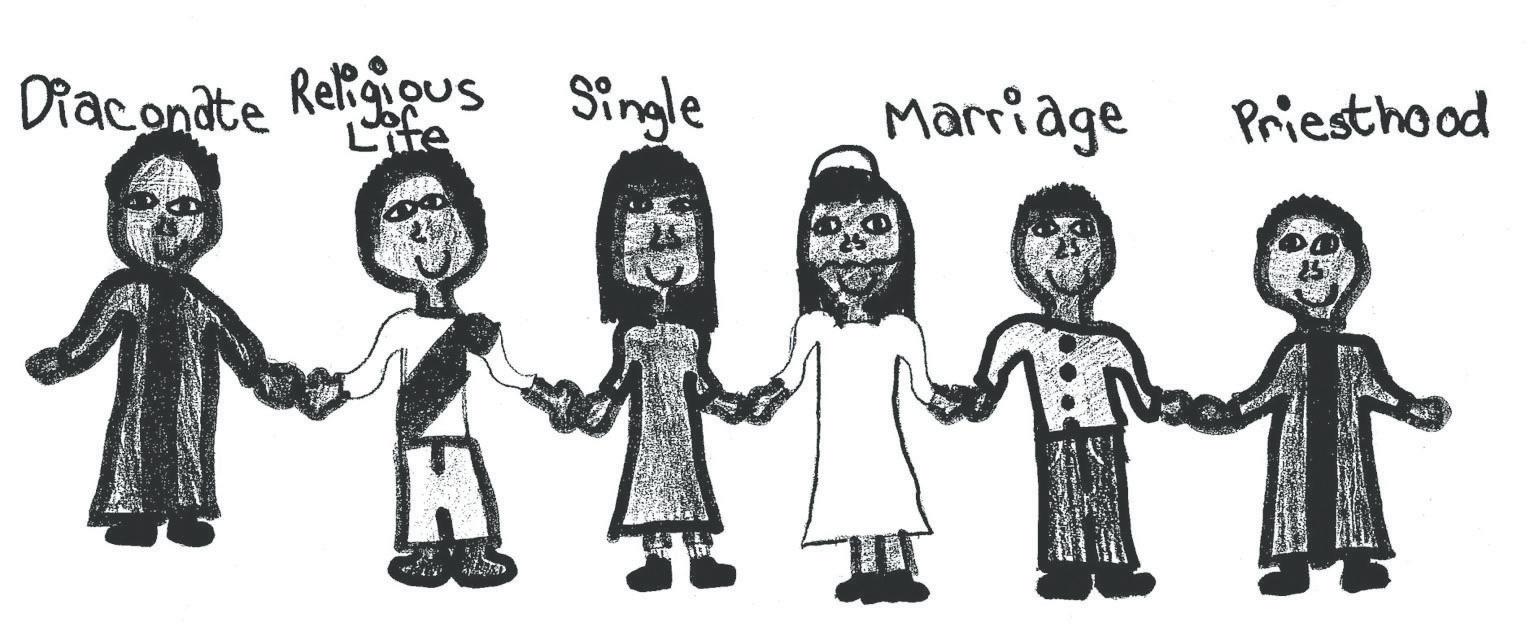
Here is an editorial titled “Got a minute? Make time to pray for vocations every day,” from the February 29 issue of The Criterion, newspaper of the Indianapolis Archdiocese in the US. It was written by Mike Krokos, editor.
■ By
Mike KrokosThe request has come dozens of times - maybe more - if you stop and think about it. It may have been a priest at your parish who asked.
Or a visiting priest or religious from mission territory.
Or here in the Archdiocese of Indianapolis, the request may have come from Archbishop Daniel M. Buechlein himself.
How many times have you been asked to pray for vocations to the priesthood and consecrated life?
In a world where we take so much for granted - a roof over our heads, a living wage that helps put food on the table and a loving family, among other things for most of us - our faith empowers followers of Christ to do much with the gifts that our Creator has given to each of us. What bigger gift can we offer
to others than our gift of prayer?
While people of faith take to heart Lent’s message of prayer, fasting and almsgiving, what prevents us from taking a moment each day, outside the Lenten season, to offer a prayer for vocations?
It would be so simple, we have heard priests or religious tell us on occasion.
As people of faith, why not make time each day to pray a Hail Mary or another simple petition for an increase in vocations to the priesthood and consecrated life?
The question we should be asking ourselves this Lenten season and beyond is how many times have we followed through on that simple request? And why, with apologies to Nike and its advertising catchphrase, can’t we “just do it?”
In his message for the World Day of Prayer for Vocations, observed on April 13 in most countries, Pope Benedict XVI reminds us that parish communities with a real sense of obligation to spread the Gospel are places where vocations to be priests and religious, including as missionaries, thrive.
“There have always been in the church many men and women who, prompted by the action of the Holy Spirit, choose to live the Gospel in a radical way, professing the vows of chastity, poverty and obedience,” he said.
Pope Benedict said that those on the front lines of the church’s
work in missionary territories almost always are the priests and religious women and men who consecrate their whole lives to serving God and humanity.
Look around the archdiocese. Where are seeds of vocations being planted and flourishing? In parishes with “spiritual soil,” as our Holy Father puts it.
Churches that have perpetual adoration like Our Lady of the Greenwood Parish in Greenwood, where individuals are committed to praying for vocations, can see their petitions bearing fruit.
There are currently six men from the parish at either St. Meinrad School of Theology in St. Meinrad or the Bishop Simon Brute College Seminary at Marian College in Indianapolis studying for the priesthood.
Other members of the parish have in recent years entered religious orders or are currently discussing a call to consecrated life.
While the Holy Father’s 2008 vocations message includes a special focus on the missionary aspect of our church and a reminder that all Christians have an obligation to support missionaries materially and with our prayers, he reminds us that we must also pray for more vocations to the priesthood and religious life.
Don’t let anyone tell you differently: Prayer makes a difference. What’s stopping you. “Hail Mary, full of grace ... .”
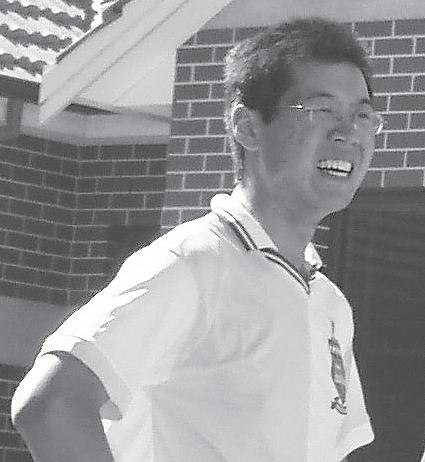
Called: Brennan Sia
Here we present part two of our series of testimonies by seminarians on how they found their vocation.
BRENNAN SIA, a thirdyear student and Aquinas College old boy, tells his story.
My family moved here from Malaysia almost twenty years ago when I was six years old.
I am the eldest of three boys, and my family has always been a part of Bateman Parish, which started up shortly after we arrived in Perth.
After finishing my schooling at Aquinas College in 1998, I went on to Curtin University and received a Bachelor of
 ■ By Fr Gerard Wilberforce
■ By Fr Gerard Wilberforce
Iam writing as the great great grandson of William Wilberforce, who campaigned vigorously for the ending of the transatlantic slave trade in 1807, which ultimately paved the way for the abolition of slavery itself throughout the entire British Empire in 1833.
I am often asked what would be the campaigns Wilberforce would be fighting if he were alive in 21st century Britain.
I believe that there would be a number of different issues - among them human trafficking and the scourge of drugs. But almost certainly at the top of the list, would be the issue of abortion.
As the Human Fertilisation and Embryology bill comes before Parliament over the next few weeks, the opportunity presents itself to amend the abortion act.
With the number of abortions having reached 200,000 per year in the UK alone, the time is right to tighten up the law that was designed to protect women
by ending illegal abortion, but never to allow such a high degree of deprived life.
There are great similarities between the status of the foetus and the status of African slaves two centuries ago.
Slaves were considered a commodity to do with whatever the vested interests of the day decided.
Today, in our desire to play God in our embryology experimentation, with all its unfulfilled promises of miracle cures, and our decision to abort unwanted children, we are no better tha those slave traders who put their interests and world view higher than they placed the sanctity and value of human life.
Most people at the time didn’t believe the evil of slavery could ever be defeated, as so much of the economy at the time was dependent on the trade.
It’s easy for us to think that is the case today with abortion, but I believe William Wilberforce would not take such a view.
Whilst our hearts go out to those who have chosen abortion, there should now be much greater emphasis on the alternatives that exist. Many of us would
like to see far more support for those who have made such a significant and difficult decision – but whilst we recognise the trauma many women have gone through, we also have a duty to ‘Speak up for those who cannot speak for themselves’ (Proverbs 31).
The Psalmist says ‘My frame was not hidden from you when I was made in the secret place.’
With abortions in the UK reaching 600 a day, it seems to me that the ‘secret place’, is one of the most dangerous places to be in modern day Britain.
As with my great ancestor, the battle took many years, even decades. But now, with the passage of time we look back in horror at how we devalued human life.
I truly believe we will look back in years to come, repent and ask forgiveness for what we let happen to the unborn child.
There is something deeply depressing about a society in which abortion is so easy, yet alternatives such as adoption appears so difficult.
Fr Wilberforce, a convert to Catholicism, writes from Britain
was ‘etched’ into the back of the mind
Pharmacy at the end of 2003. From there I went to do my training to become a registered pharmacist and became a fully-fledged pharmacist in early 2005.
After that, I was mainly based at the Mount Hospital before entering the seminary. I guess the thought of becoming a priest was always etched somewhere at the back of my mind since I was about ten years of age. It would be hard for me to pinpoint one or even several things that were definitive in leading me to join the seminary: there are quite a
number of them — some big, some small — but all have contributed to my being where I am today. There is not enough space here for me to describe any of them in detail, but what has been constant in my journey towards the seminary has been a deep certainty that this is what God wants me to do with my life, and that He will not abandon us, especially those who respond to His call.
Already within my first year at the seminary, I (with another seminarian here) had the great privilege of taking part in the exchange program our
seminary has with a Greek Orthodox seminary in Athens. Seminary life so far, for me, has been a real learning experience and it encompasses not only the academic but also the spiritual, pastoral and human side as well. Like all directions that can be taken in life, there are moments that are enjoyable and those that are not so. However, though the Cross is always a part of our life journey, in some way it makes the journey easier in that it can operate as a compass and help keep us on track to where the Lord is guiding us.

Iam the World Youth Day Coordinator for the Archdiocese of Perth. I have been to three World Youth Days. They’re a spiritual boost and an important part of my faith journey.
The first WYD I went to was held in 2000 in Rome. I experienced an overwhelming feeling of joy and so much positive energy there. I was surrounded by a sea of happy young people. I saw Pope John Paul II. You could see he was a holy man and it almost brought you to tears when you saw him.



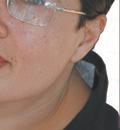 with Debbie Warrier
with Debbie Warrier
At the Rome WYD, there were the worst living conditions. It was 40 degrees everyday, we slept on concrete floors and generally it was uncomfortable. But none of that mattered.
What were important were the people, the journey, Rome, St Peter’s Basilica and seeing the centre of the Church. You learn so much on WYD because it is a saturation of faith in the one place. My job now is about me giving back what everyone at WYD has already given to me.
There is no typical day at work! There is so much going on. I have an open dialogue with God all the time. I let the Spirit work through me. I say, “God guide me in what I am doing now.” I offer myself to His services. In my silent moments when I’m traveling I pray and listen. I should set up a chapel in my car!
I remember once the computers went down in the office. It was difficult because you depend on your computers so much for everything. I took a look around the office and it looked like a bomb had hit it. I saw the mess and thought, “OK God I can see what you’re telling me.” We cleaned up and got so much work done.
Through my work my whole life has become a prayer. I try to go to daily Mass as much as possible. I can pray anytime, anywhere and any place. I sing along to Christian music on my CD’s in the car. Music is a big part of my prayer life.
I am a cantor in my parish and lead the youth music ministry team. St Augustine said, “When you sing, you pray twice.”
My faith experiences have been quite varied. I’ve experienced praise and worship from the Charismatic movements and even Pentecostal Churches. I also enjoy Adoration, Taize style chanting and of course the Catholic Mass.
My faith is everything to me. It’s who I am and how I live my life. It means that I have hope and salvation in Jesus Christ.
Faith is the embracing of God’s love. It’s being open to the miracles that happen everyday. It’s saying, “Something great happened today and that was a blessing from God.”
It’s hard being spiritual in Australia where all your needs are gratified instantly. In the Third World Countries spirituality is so strong because that is all they have.
It’s hard to show people who have so many things that there is so much more for them spiritually. They say, “God, make this happen straight away.” That’s not what faith is about. A spiritual life encourages you to slow down. It’s about stepping back and offering yourself up to God..
debwarrier@hotmail.com



Pope urges US Catholics to become evangelisers of their nation, culture
■ By John ThavisWASHINGTON (CNS)Celebrating Mass in a Washington baseball stadium, Pope Benedict XVI urged US Catholics to renew their missionary energy at a time when American society is at a moral crossroads.
The Pope warned of “signs of a disturbing breakdown in the very foundations of society” and said people need the Church’s message of hope and fidelity to the demands of the Gospel. He also confronted the question of clerical sexual abuse of minors, acknowledging the damage done to the Church and asking all Catholics to help assist those who have been hurt. The Mass on April 17 at a packed Nationals Park was the Pope’s first major encounter with the Catholic faithful on his six-day visit to Washington and New York.
The liturgy, celebrated on an altar platform in deep centre field, was a Mass of the Holy Spirit and featured multiethnic choirs singing in four languages.
The prayer of the faithful was read in English, Tagalog, Korean, Vietnamese, Igbo and Spanish. It included petitions for Pope Benedict and all bishops, for peace in the world, for the safety of those who seek to achieve peace, for children everywhere, for those who suffer, for those who are ill, and for all who have died. The assembly responded to each Mass intention with a trilingual response sung in English, Latin and Spanish.
During the offertory procession, four groups of gift-bearers approached the altar with bread and cruets. One group, from Medley’s Neck, Maryland, included four generations from one family. Students from college campus ministries and area high schools, men and women religious, and four people with disabilities and their companions also carried gifts. The spirit was evident among the enthusiastic crowd of about 45,000 people, who cheered the 81-year-old Pope as he rode through the stadium in his popemobile. The Pope smiled, waved


and looked delighted at the panorama of faces and fluttering yellow flags, as the choirs sang English and German versions of “Holy God, We Praise Thy Name.”
Anne Murphy, a member of Blessed Sacrament Parish in Alexandria, Virgina, remarked on the “spirit of togetherness” the Pope’s presence had brought. “I think it’s a very exciting opportunity for people throughout the country to witness the kind of spir-
itual power that Benedict brings to the world,” she said.
“It’s the kind of thing that makes you proud to be a member of the Catholic community and to be here today,” she said.
After the Pope processed to the altar, he was welcomed by Washington Archbishop Donald W. Wuerl, who told him US Catholics looked to him for “renewed inspiration to continue the challenge to make all things new in Christ our
hope.” The Pope, dressed in red vestments, opened his arms wide in appreciation.
In his homily, the Pope said he had come to encourage the Church in America to build on its accomplishments and respond to new challenges through an “unceasing missionary outreach.”
He invoked a new chapter of the descent of the Holy Spirit at Pentecost, saying US Catholics need to give their contemporaries “a convincing account of the hope which inspires them.” “The world needs this witness. Who can deny that the present moment is a crossroads, not only for the Church in America but also for society as a whole?” he said.
The Pope said that it was a positive thing that global connections were drawing people together today. “Yet at the same time we see clear signs of a disturbing breakdown in the very foundations of society: signs of alienation, anger and polarization on the part of many of our contemporaries; increased violence; a weakening of the moral sense; a coarsening of social relations; and a growing forgetfulness of God,” he said. This crossroads is also reflect-
ed inside the church, he said. He cited the vitality of movements and parish life and increased interest in prayer and Catholic education.
Yet the Church faces the “troubling realisation” that many of its members, “rather than acting as a spiritual leaven in the world, are inclined to embrace attitudes contrary to the truth of the Gospel.”
Today’s challenges require sound instruction in the faith, especially among the young, he said. But they also call for “cultivating a mindset, an intellectual culture, which is genuinely Catholic” and can bring the Gospel to bear on the urgent issues American society faces, he said.
The Pope spoke about sexual abuse by priests for the third time in three days. The evening before, he addressed the bishops; this time, he aimed his comments at the entire U.S. Catholic community. He also spoke about it to journalists on the papal plane from Rome April 15.
“No words of mine could describe the pain and harm inflicted by such abuse. It is important that those who have suffered be given loving pastoral attention,” he said.
He lauded the efforts to deal “honestly and fairly with this tragic situation, and to ensure that children - whom Our Lord loves so deeply and who are our greatest treasure - can grow up in a safe environment.” “I encourage each of you to do what you can to foster healing and reconciliation and to assist those who have been hurt. Also, I ask you to love your priests and to affirm them in the excellent work that they do,” he said.
The pope said the Church’s ability to heal wounds and overcome divisions depends in part on the rediscovery of the “liberating power” of the sacrament of penance.
That will help the Church in the United States become a “leaven of hope” in society, and take its place in the long story of the Church’s expansion, he said.
The Pope spoke about the past injustices endured by native Americans and by Africans brought forcibly to the country as slaves. But essentially, he said, Americans have always been a people of hope and open to the Christian message.
At the end of his homily, the Pope spoke in Spanish, thanking the increasing number of Hispanic Catholics for adding vitality to the Church in the United States.
- Contributing to this story was Mark Pattison.
Name:
Address:
Suburb:
Postcode:







Benedict urges youth to see him again in Sydney in July
■ By Benedicta CipollaAddressing a crowd of 25,000 young people and seminarians, Pope Benedict XVI spoke of the “monster” that cast a shadow over his own childhood and urged the current generation to banish the darkness that exists today.
Speaking on April 19 at a boisterous rally on the grounds of the Archdiocese of New York’s seminary in Yonkers, the Pope said that while young people now enjoy democracy’s freedom “the power to destroy does, however, remain.”
Pope Benedict offered a personal reflection on his own youth in Germany, “marred by a sinister regime that thought it had all the answers.” Nazism, he said, “banished God and thus became impervious to anything true and good.”
The Pope was forced to enroll in Hitler Youth as a boy but soon stopped going to meetings. Last year he said at a youth meeting in Germany that he decided to become a priest after witnessing the Nazis’ brutality.
At St Joseph’s Seminary, the Pope said the evils of substance abuse, homelessness and poverty, racism, violence and the degradation of girls and women result in people being treated as objects and the denial of God-given human dignity.
Pope Benedict called the manipulation of truth “particularly sinister.” When freedom disregards absolute truth, relegating it instead to the private sphere of the individual, relativism takes hold, he said.
Truth is neither an imposition nor a simple set of rules.
“Ultimately truth is a person: Jesus Christ,” he said.
During the meeting, young people from schools in the region presented the Pope, who celebrated his 81st birthday on April 16, with several gifts, including framed pictures of Sts Elizabeth Ann Seton, Frances Xavier Cabrini and John Neumann, Blessed Kateri Tekakwitha, and Pierre Toussaint and Father Felix Varela, who have been declared venerable in the sainthood process.
All of them were either born or served in New York. He also

those in power banish God, thus becoming impervoius to what is true and good. Meanwhile, women applaud a talk by the Pope during the rally. Pope Benedict urged those present, and through them all their contemporaries, to follow the examples of the saints.
Such lives are desperately needed in a world groaning under the weight of consumerist greed, he said.
PHOTO: CNS/NANCY WIECHEC.received books on the history of the Catholic Church in New York, and bread, rice and maize, which symbolized the varied cultural backgrounds of the youths present.
The saints’ diverse backgrounds and missions illustrate the breadth and possibilities of Christian discipleship, which should not be viewed through a negative prism of do’s and don’ts, said the Pope.
“Sometimes we are looked upon as people who speak only of prohibitions. Nothing could be further from the truth,” he said.

The saints’ examples also propel people to renewed social action against today’s injustices, such as the environmental damage done to the earth, which “groans under the weight of consumerist greed and irresponsible exploitation,” the Pope said.
The rally gathered young people and seminarians, and Pope Benedict encouraged those studying for the priesthood to “reject any temptation to ostentation, careerism or conceit. Strive for a pattern of life truly marked by charity,
chastity and humility, in imitation of Christ,” he said.
At the end of his English remarks, the Pope stood up, but an aide turned the page of his text. Laughing, the Pope said, “I forgot my Spanish.”
As he began reading the text, there were cheers from the crowd.
Ebi Ogbu, 22, a forensic psychology major who presented the welcome message to Pope Benedict, told Catholic News Service: “A lot of young people struggle with faith, and they get God out of their lives.
The full text of Pope Benedict’s remarkable and inspiring message to young people can be found on The Record’s website at: www.therecord.com.au
There’s a lot of peer pressure in terms of what the media sells, and it’s hard to break away from that when everyone is doing it.
“Nobody should be afraid to let go and let God work in their lives,” she said.
After the service concluded, Gabriella Fiorentino, 18, said she was surprised when she presented the pope with the picture of Blessed Kateri and got to kiss him on both cheeks. “We knew we’d get to see him and stand right near him, but then he called us up.
I wish everyone could have the feeling I had when I was up there with him,” she said.
One chaperone said he was particularly impressed by the Pope’s address. “What I think was interesting was that the message had so much substance and it wasn’t so sound-bite-driven.
That was good for the kids,” said Mike DeBartolo, who accompanied about 40 young adults from Resurrection Church in Rye, New York.
Before the rally, pop singer Kelly Clarkson and other musicians performed at an outdoor concert against a backdrop of the risen Christ. With a cloudless sky and temperatures in the 20s, the festive atmosphere felt like the first taste of summer.
Displaying one of the biggest smiles of his trip to the United States, the pope revved up the crowd just after his late-afternoon arrival when he stepped to the edge of the stage to grab some of the outstretched hands.
The crowd also sang “Happy Birthday” in German to the pope, who gave them an “A-plus” for pronunciation. His next major encounter with young people will be in July at World Youth Day in Sydney, Australia.
- CNS. Contributing to this story was Beth Griffin.
Benedict appeared unconcerened about security: father of girl
■ By Benedicta CipollaNEW YORK (CNS) - In an unscheduled April 19 event, Pope Benedict XVI greeted about 40 disabled children and their family members from Ronald McDonald House in New York.
At about 8 pm, chaplain Cherilyn Frei received a call from James Murtagh, the commanding officer of the New York Police Department’s 19th Precinct saying that the Pope wanted to greet neighbourhood residents outside Archbishop Celestino Migliore’s residence, where he was staying.
The precinct’s jurisdiction includes Ronald McDonald House and the archbishop’s resi-
dence, and officers helped provide security during Pope Benedict’s April 18-20 New York visit.
“I ran down the halls, knocked on some doors and basically we threw them into vans and took off,” Frei told Catholic News Service.
The group waited for 30 minutes before Pope Benedict emerged close to 9 p.m.
The families, standing behind metal barricades set up outside the residence, held up their children to receive the pope’s blessing.
About 80 people from the neighbourhood, including priests from St Catherine of Siena Church, also attended.
“That’s probably the one human being on earth that I believe is the closest to the Lord,” said Charles Griffin, who met the Pope with his wife, Sonia, their 5-year-old daughter, Faith, and 2-year-old son, Elijah, and his mother, Bernadette. Faith suffers from a brainstem glioma, an inoperable tumor that
affects her speech, balance and sight. The Griffins, who are from Weston, Florida, stay at Ronald McDonald House for weeks at a time when Faith undergoes treatment at New York University Medical Centre. Ronald McDonald Houses, located all over the country, provide temporary housing for a nominal fee to pediatric cancer patients and their families who come in from out of town for treatment.
The New York house, in Manhattan, can accommodate 83 families and, according to officials with the facility, it is filled to capacity almost every night.
“It speaks volumes about the kind of Pope he is,” said Charles Griffin, who is Lutheran. His wife is Catholic.
“My understanding is he gave the police department some troubles in the sense that he kind of went wherever he wanted to. He didn’t care (about security). He came here to see people and to pray.” Griffin said Faith recip-
rocated Pope Benedict’s blessing. “She loves touching people’s foreheads and going like this,” he said, making the sign of the cross. Two children from the house were among 56 disabled youths who participated in an officially scheduled meeting with the Pope earlier in the day in the chapel at St. Joseph’s Seminary in Yonkers.
Officers from the 19th Precinct have been involved with Ronald McDonald House for several years as part of their community outreach program and had hoped to get some of the children to see Pope Benedict.
“The Pope’s people said he wanted to come outside to address the neighbourhood, and so we called Ronald McDonald House and anyone else we could think of that could get there in half an hour,” said Officer Liam Lynch. All who attended said they appreciated the last-minute, unscripted moment. “We’re nobody special or famous, and here we were inches away from the Pope,” said Frei.




- Neither government nor religion has a right to change or limit human rights, because those rights flow from the dignity of each person created in God’s image, Pope Benedict XVI said.
In his April 18 speech to the UN General Assembly, the Pope insisted that human rights cannot be limited or rewritten on the basis of national interests or majority rule.
But he also said the role of religion is not to dictate government policy, but to help their members strive to find the truth, including the truth about the dignity of all people, even if their religious views are different.
UN Secretary-General Ban Kimoon welcomed the Pope and met privately with him before the pontiff addressed the General Assembly.
In his address, the German-born Pope Benedict said he came to the United Nations as a sign of his esteem for the organisation, founded after the devastation of World War II when several governments ignored the fact that human beings were created by God and that the basic principles of right and wrong are written in the heart of each person.
“In consequence,” he said, “freedom and human dignity were grossly violated.”
The Pope, always a strong supporter of the UN and its efforts to avoid conflicts and end wars, insisted that when one country has a problem with another, it must not act unilaterally, but seek the

assistance of the UN. As expected, the Pope also paid tribute to the Universal Declaration of Human Rights, adopted 60 years ago.
He said the document - proclaiming the equality of all people, the basic right to life and to freedom, liberty of conscience and the free practice of religion - was the result of “a convergence of different religious and cultural traditions.”
“The rights recognised and expounded in the declaration apply to everyone by virtue of the com-
mon origin of the person, who remains the high point of God’s creative design for the world and for history,” Pope Benedict said. “They are based on the natural law inscribed on human hearts and present in different cultures and civilisations,” he said.
The Holy Father said it was essential people and governments recognise they are not the creators of human rights and they cannot limit them.
Religious freedom is an essential
human right, he said, and when exercised as a search for truth, religion can promote a broader recognition of human rights.
“A vision of life firmly anchored in the religious dimension can help to achieve this since recognition of the transcendent value of every man and woman favours conversion of heart, which then leads to a commitment to resist violence, terrorism and war and to promote justice and peace,” the Pope said. He added that interreligious dia-
logue contributes to global peace and the defence of human rights when it brings believers together in their search for truth.
The task of religions, he said, “is to propose a vision of faith not in terms of intolerance, discrimination and conflict, but in terms of complete respect for truth, coexistence, rights and reconciliation.”
While religions have an obligation to promote recognition of human rights, they also must defend the rights of their members to bring the values of their faith to bear on the decisions they make as citizens.
“It is inconceivable, then, that believers should have to suppress a part of themselves - their faith - in order to be active citizens,” he said.
“It should never be necessary to deny God in order to enjoy one’s rights.”
The Pope asked the United Nations and the world’s governments to make special efforts to defend religious freedom in societies where extreme secularism tends to push believers out of the public sphere and where one religion has been adopted as the national religion and other believers suffer discrimination or oppression.
The Pope also told the United Nations “the promotion of human rights remains the most effective strategy for eliminating inequalities between countries and social groups and for increasing security.”
When dignity is attacked and when people live in hardship and despair, he said, they become “easy prey to the call to violence.”
In an unprecedented move Pope Benedict spoke five times in five days of the clergy sex abuse scandal that devastated American Catholics. Such abuse, he said, is a ‘countersign’ to the Gospel of life
■ By
Julie AsherWASHINGTON (CNS) - One of the “countersigns to the Gospel of life” in the United States is the sexual abuse of minors, a situation “that causes deep shame,” Pope Benedict XVI told about 300 US bishops gathered on April 16.
During his speech in the crypt church at the Basilica of the National Shrine of the Immaculate Conception in Washington, the Pope called it an “evil” and said the US bishops have “rightly moved” to address it.
The programs they have put in place to discipline church members who are abusers, to create safe environments protecting young people, to foster healing and to “bind up the wounds” caused by “every breach of trust,” are bearing fruit, he said.
But the Pope also said the problem of sex abuse must be placed in a wider context when pornography, violence and “the crude manipulation of sexuality” are so prevalent
WASHINGTON (CNS) - Pope Benedict XVI held an unscheduled meeting with victims of priestly sexual abuse, shortly after pledging the church’s continued efforts to help heal the wounds caused by such acts.
The Vatican said the Pope met privately in a chapel at the apostolic nunciature with “a small group of persons who were sexually abused by members of the clergy.” The group was accompanied by Cardinal Sean O’Malley of Boston, which was the epicentre of the abuse scandal.
“They prayed with the Holy Father, who afterward listened to their personal accounts and offered them words of encouragement and hope,” a Vatican statement said.
“His Holiness assured them of his prayers for their intentions, for their families and for
in society today. Inside the shrine he prayed silently at the Blessed Sacrament Chapel and then at the Oratory of Our Lady of Altotting, the patroness of Bavaria, in his German homeland.
This was followed by the vespers service with the US bishops and the Pope’s address to them in the crypt church.
After the evening prayer service, Chicago Cardinal Francis George, president of the US Conference of Catholic Bishops, said in a talk that
all victims of sexual abuse,” it said. Jesuit Father Federico Lombardi, Vatican press spokesman, told journalists the meeting involved five or six victims, men and women from the Archdiocese of Boston, and lasted about 25 minutes. During the encounter, each of the victims had a chance to speak personally to the Pope, who spoke some “very affectionate words,” he said.
Father Lombardi said it was a very emotional meeting; some were in tears.
At the meeting’s conclusion, Cardinal O’Malley gave the Pope a book listing the first names of the approximately 1000 victims of sexual abuse in the Archdiocese within the last several decades, Father Lombardi said, so the Pope could remember them in his prayers.
The Pope spoke five times about clerical sexual abuse during his six-day visit to the United States, expressing the sense of shame he and other church leaders feel about what he called a “tragic situation.”
On each occasion, he made a point to encourage church leaders and all Catholics to help those harmed by the abuse.
On the plane taking him to the United States
the bishops greeted the Pope not as a foreign visitor but as “a father and a friend in Christ.”
“In our own day, the consequences of the dreadful sin of sexual abuse of minors by some priests and of it sometimes being very badly handled by bishops make both the personal faith of some Catholics and the public life of the church herself more problematic,” the cardinal said.
In his own talk, the Pope said priests themselves “have experi-
on April 15, Pope Benedict told reporters: “If I read the histories of these victims, it’s difficult for me to understand how it was possible that priests betrayed in this way their mission to give healing, to give the love of God to these children.”
Addressing the US bishops on April 16, he said sexual abuse was one of the “countersigns to the Gospel of life” and lauded their efforts to ensure these acts will not happen again.
At a Mass in Nationals Park on April 17, he said “no words of mine could describe the pain and harm inflicted by such abuse. It is important that those who have suffered be given loving pastoral attention.”
The Pope lauded the efforts to deal “honestly and fairly with this tragic situation and to ensure that children - whom Our Lord loves so deeply and who are our greatest treasure - can grow up in a safe environment.”
“I encourage each of you to do what you can to foster healing and reconciliation and to assist those who have been hurt. Also, I ask you to love your priests, and to affirm them in the excellent work that they do,” he said.
enced shame” over abuse carried out by fellow clergy and others and need the bishops’ “guidance and closeness during this difficult time.”
He added people must remember the “overwhelming majority” of priests and religious in the US do “outstanding work.”
The Pope also addressed the effect of secularism and materialism on how Catholics and others live out their beliefs in the world, the state of the family within society, Catholics leaving the faith and
the need for vocations. His comments on secularism, the issue of some Catholics leaving the faith and vocations were in response to prepared questions from the bishops. He talked about the role of the bishops in addressing the issues of the day, especially during an election year when church leaders cannot assume “all Catholic citizens think in harmony with the church’s teaching on key ethical issues.” “It falls to you to ensure that the moral




YONKERS, N.Y. (CNS) - In the most intimate public event of the papal visit so far, Pope Benedict XVI blessed 56 disabled youths and their caregivers in the chapel of St Joseph’s Seminary in Yonkers on April 19.
“God has blessed you with life, and with differing talents and gifts.
Through these you are able to serve him and society in various ways,” the Pope said.
“While some people’s contributions seem greater and others’ more modest, the witness value of our efforts is always a sign of hope for everyone.”
“Sometimes it is challenging to find a reason for what appears only as a difficulty to be overcome or even pain to be endured. Yet your faith helps you to break open the horizon beyond your own selves in order to see life as God does.
“God’s unconditional love, which bathes every human individual, points to a meaning and purpose for all human life,” he continued.
“Through his cross, Jesus in fact draws us into his saving love and in so doing shows us the way ahead - the way of hope which transfigures us all, so that we too, become bearers of that hope and charity for others.”
The youths, ranging in age from 3 to 18, were chosen from throughout the Archdiocese of New York by Catholic Charities and
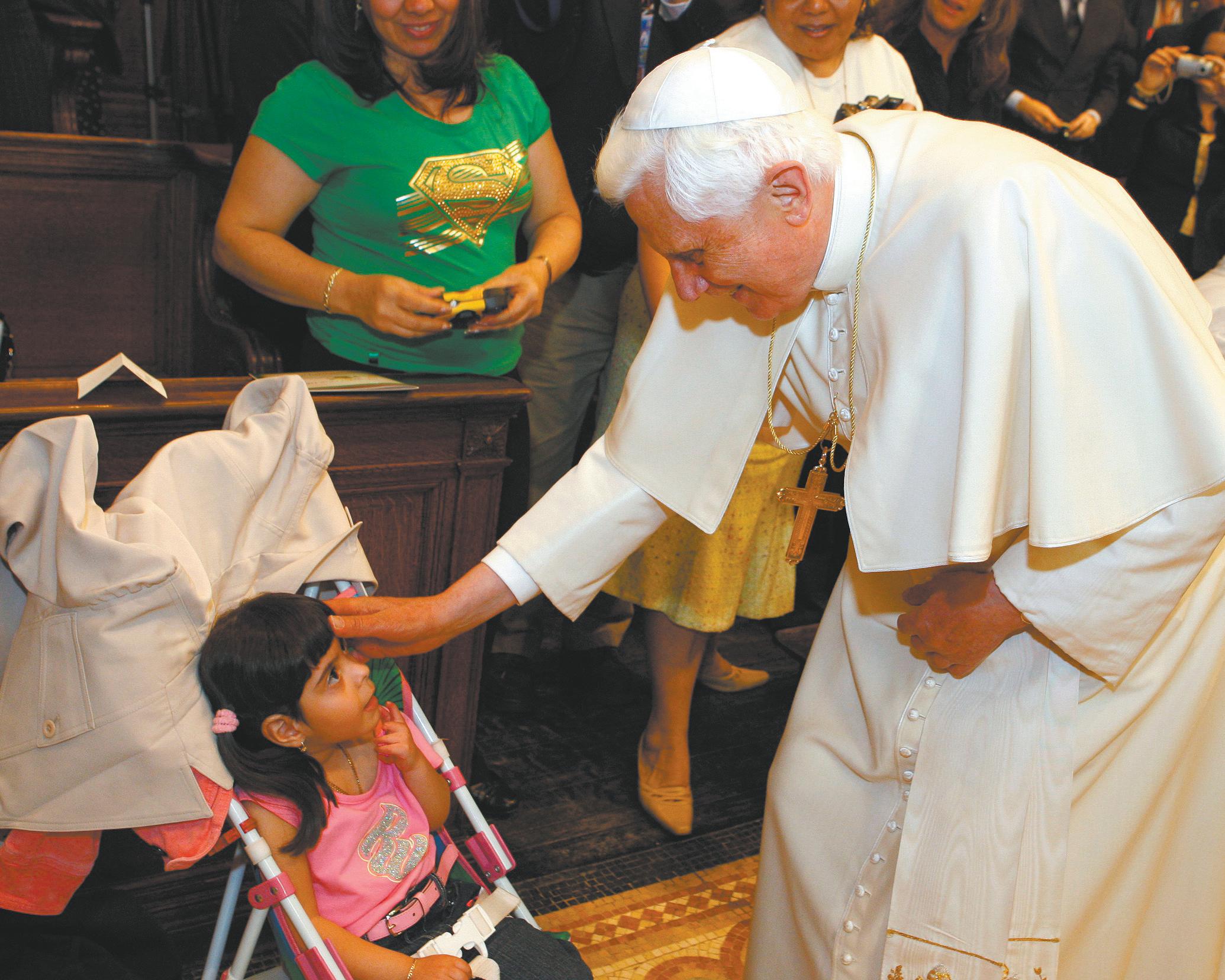
displayed a range of physical, emotional and developmental disabilities. Some were in wheelchairs or strollers, while others sat with their caregivers in the pews, facing the centre aisle of the small chapel. The Pope was welcomed to St Joseph’s by New York Auxiliary
Bishop Gerald Walsh, rector of the seminary, and by Cardinal Edward Egan of New York. He entered the building to cheers of “Benedetto!” (“Benedict” in Italian) from those who had gathered outside to catch a glimpse of his arrival.
As he walked up the chapel’s aisle, he greeted each individually, laying a hand on some of the children’s heads, grasping their hands, coddling their faces or tracing a blessing on foreheads.
At the front of the chapel, he greeted and spoke quietly with a
smiling Monsignor Kevin Sullivan, director of Catholic Charities for the Archdiocese of New York.
Three youths then approached the Pope: Neyshadli Kenney, from St Ursula Learning Centre in Mount Vernon; Lauren Kurtz from Holy Family Parish in the Bronx; and Caitlin Menno from St Charles Parish on Staten Island.
Kenney thanked the Holy Father for taking the time to visit.
“Your presence inspires us to be stronger Christians and love Jesus more,” she said.
“May your presence also remind everybody in our world that all human life is sacred, even when challenged.”
Kurtz and Menno presented the Pope with a painting by a young artist who lives at a Catholic Charities residence.
The Cathedral of St Patrick Young Singers and the New York Archdiocesan Deaf Choir performed “Take Lord, Receive” by Jesuit Father John Foley.
The deaf choir, a group of 16 adults based at St Elizabeth of Hungary Parish in New York, is led by Monsignor Patrick McCahill.
The priest learned American Sign Language while he was a seminarian at St Joseph’s 40 years ago and is the moderator of the New York Archdiocesan ministry for the deaf and the pastor of St Elizabeth.
Before giving his apostolic blessing to the crowd, he encouraged the youths and their caregivers to “pray every day for our world.”
“There are so many intentions and people you can pray for, including those who have not yet come to know Jesus.”

formation provided at every level of ecclesial life reflects the authentic teaching of the Gospel of life,” the Pope said, noting hat throughout the world there is “proposed legislation that gives cause for concern from the point of morality.”
He did not mention specific issues, but said the Catholic community under the bishops’ guidance “needs to offer a clear and united witness on such matters,” and the minds and hearts of the wider community must be opened “to moral truth.”
Regarding the sex abuse scandal, he said, “Many of you have spoken to me of the enormous pain that your communities have suffered when clerics have betrayed their priestly obligations and duties by such gravely immoral behavior.”
Although the pontiff praised the bishops’ measures to address the scandal at all levels, he said if such policies are to achieve “their full purpose,” they must be placed “in a wider context” of sexual mores and children must grow up “with
a healthy understanding of sexuality and its proper place in human relationships.”
He said the values “underpinning society” need to be urgently reassessed to provide a sound moral foundation for children and youth.
Children “have a right to be educated in authentic moral values rooted in the dignity of the human person,” the Pope said.
“By acknowledging and confronting the problem when it occurs in an ecclesial setting, you can give a
lead to others, since this scourge is found not only within your diocese, but in every sector of society. It calls for a determined collective response,” he said.
Children must “be spared the degrading manifestations and the crude manipulation of sexuality so prevalent today,” he said.
Offering a sound moral foundation to children is the responsibility not only of parents but of religious leaders, teachers and catechists, and “the media and entertainment industries.”
Regarding other issues, Pope Benedict praised Americans for having “a genuinely religious spirit,” but said secularism and materialism can subtly influence the way people live out their faith. He questioned why members of the faithful who worship in church on Sunday act contrary to their beliefs and church teaching during the rest of the week.
A sense of individualism can affect how people approach their faith, leading them to pick and choose what they believe, he said. “We’ve seen this emerge in an acute way in the scandal given by Catholics who promote an alleged right to abortion,” he said.
He pointed to people ignoring or exploiting the poor, or promoting business practices, sexual behavior or positions on right-to-life issues that are contrary to Catholic moral teaching.
He also talked about the state of the family, saying a healthy family life contributes to “peace in and
between nations.” In the family home, he said, people learn about justice and love, the role of authority and concern for one another.
But increasing rates of divorce and infidelity, delayed marriage, more cohabitation and a growing disregard for the sacramental bond of marriage are hurting the institution of marriage and eroding family as a basic building block of society, he said.
He also said the family is the primary place for evangelisation and passing on the Catholic faith.
The church needs to discover “new and engaging ways of proclaiming” the message, in a society in which religion is often becoming too much of a private matter, and as such “loses its very soul,” according to the Pope.
Regarding vocations, he said, “The ability to cultivate vocations to the priesthood and the religious life is a sure sign of the health of a local church.”
He urged the faithful to pray for vocations, but added that prayer is important not just for vocations.
He encouraged the bishops to create opportunities for young people who want to explore a vocation also to talk to their peers about the possibility, and to encourage all their priests to come together for dialogue and fraternal encounters.
The Holy Father urged all priests to overcome any divisions they have among them, to move beyond disagreements and listen to one another and “the Spirit, who is guiding the church into a future of hope.”
Sunday April 27
HOLY HOUR
4th Sunday of the month, 2-3pm for vocations to the Priesthood and Religious Life. Infant Jesus Church, Wellington Road, Morley. “Let us continue to implore our God to rain down an abundance of new life into our Church, and to open our hearts and those of the young people of the world to really hear His Word for us now, today” (Religious Sister). Enq: 9276 8500.
Sunday April 27
ETERNAL WORD TELEVISION NETWORK: EVERY SUNDAY, 1 2 PM ON ACCESS 31
April 27: The meaning of marriage / Dr Robert George with the Panel [Franciscan University Presents]. Your help is needed to keep these programs on air. Please send donations to The Rosary Christian Tutorial Association, P.O. Box 1270, Booragoon 6954. Enq: 9330-2467.
Sunday April 27
PERTH WYD SUNDAY SESH #3 AT APPLECROSS PARISH
Youth Mass starting at 6pm and Sunday Sesh at 7.15pm. St Benedict Parish, 115 Ardross Street, Ardross. The Sunday Sesh is back again! April’s theme: “Developing our own journey with Christ” and Journey of the Cross and Icon (JCI)”. Learn more about the WYD Cross and Icon to prepare for its arrival in Perth. It is an open event. All welcome. Enq: Tammy 9422 7944 or www.wydperth.com.
Monday April 28
REDISCOVERING THE MASCULINE IDENTITY
TRUE LOVE WAITS OPEN SESSION
Starting at 7.30pm at Catholic Pastoral Centre off Harold Street, Highgate. Not to be missed! Paul Kelly, husband, father and teacher will inspire and challenge a new generation of men in this seminar to live out the calling that God has placed in each man’s heart. Enq: Stephen 0431 228 630 or email: truelovewaitswa@yahoo.com
Monday April 28
COUNCIL FOR AUSTRALIAN CATHOLIC WOMEN
Scriptural Prayer Program-Ignation Spirituality
7.30 to 9pm at St Mary’s Parish Centre Franklin Street, Leederville. The prayer program continues on the 4th Monday of the month led by Sr Kathleen Brennan IBVM. All welcome. Enq: Kathleen 94987377 or kerrymac4@hotmail.com
Monday April 28 to Friday May 2
SISTER ARLENE EINWALTER SSSF
Our Lady of Grace, 3 Kitchener Street, North Beach, will host Sister Arlene Einwalter SSSF. Sr Arlene will conduct 5 evening sessions at 7.30pm on the theme of “What do we believe in?” and will also speak at all Masses on the weekend of 26 and 27 April. Sister Arlene is a School Sister of St Francis, based in Santa Fe, New Mexico. Enq: 9448 4888.
Tuesday April 29
DAY OF REFLECTION
10.30am at Our Lady of The Revelation Shrine, Bullsbrook with Rosary, followed by Holy Mass and Talks. Concluding 2pm. Celebrant, Fr Paul Fox. BYO Lunch. Enq: 9341 8082.
Wednesday April 30
THE JULIAN SINGERS
7.30pm to 9.30pm at 36 Windsor Street, East Perth. The health benefits of singing are well recognised. It reduces stress, is mentally invigorating and improves your wellbeing and happiness. We are a liturgical choir and practise every Wednesday night. Second term commences April 30. Enq: Chris 9276 2736 or Shirley 9344 2105.
Thursday May 1
BIBLE TIMELINE.
7.30pm. This is an exceptional Bible Study through both the Old and New Testaments. Can be taken for assessment or interest only. Don’t miss this opportunity and make sure you tell your friends. Will continue every Thursday. Acts 2 College, 67 Howe Street, Osborne Park. Enq: 92026859.
Thursday May 1
HEALING SERVICE
Alan Ames Ministry is holding a healing service, following 7pm Mass, at St Jude’s Catholic Church, 20 Prindiville Way, Langford. All welcome.
First Friday May 2 ALLIANCE AND TRIUMPH OF THE TWO HEARTS
Holy Mass and Eucharistic vigil at St Bernadette’s Church Glendalough. Confessions at 5.15pm. Parish Mass at 5.45pm followed by exposition of the Blessed Sacrament, hourly Rosaries, hymns and reflections etc. Vigil concludes with midnight Mass in honour of the BVM. Enq: Fr Doug Harris 9444 6131 or Dorothy 9342 5845.
Friday May 2
PROLIFE WITNESS
Commencing with Mass at St Brigid’s, Midland at 9.30am, followed by rosary procession and prayer vigil at abortion clinic. The Franciscan Friars of the Immaculate will lead us. Enq: Helene 9402 0349.
Saturday May 3
DANCING OUR JOYS
10am to 4pm. An Easter Retreat Day giving expression to gratitude and praise through creative movement and dance. St Catherine’s House of Hospitality, 113 Tyler Street, Tuart Hill. Enq: Shelley Barlow 9271 3873.
Saturday May 3
DAY WITH MARY
9am to 5pm. St Gerard Majella Church, Cnr Ravenswood Drive & Majella Road, Mirrabooka (Westminster). A video on Fatima will be shown at 9am. Includes Sacrament of Penance, Holy Mass, Eucharistic Adoration, Sermons, Rosaries, Procession of the Blessed Sacrament and Stations of the Cross. Please BYO lunch. Enqs: Franciscan Sisters of the Immaculate 9250 8286.
Sunday May 4
THE 2008 BUSSELTON MAY ROSARY CELEBRATION IN HONOUR OF OUR LADY
12.30pm at Queen of the Holy Rosary Shrine, Bove’s Farm, Roy Road, Jindong, Busselton.
Holy Concelebrated Mass led by Fr Tony Chiera 1pm. Rosary Procession and Benediction following Mass. Afternoon tea provided. All welcome! Bus bookings from Perth, Francis 0404 893 877 or 9459 3873. Note: Roy Road runs off the Bussell Highway, approximately halfway between Busselton and Margaret River.
Sunday May 4
THE PROBLEM OF REPRESENTING GOD
For 21st Century Christian and Jewish Artists. 3pm in The Boardroom, Temple David 34 Clifton Crescent, Mount Lawley. Lecture by Simon Blond, Lecturer in Visual Culture and Art History, Curtin University. $5 members, $10 non-members. Light refreshments following lecture. Email: ccjwa@aol.com or visit: www. ccjwa.org.
Sunday May 4
DIVINE MERCY
An afternoon with Jesus and Mary will be held at St Joachim’s Church, on the corner of Shepperton Road and Harper Street in Victoria Park starting at 1.30pm. Program: Holy Rosary and Reconciliation, Sermon: with Fr John Joseph FFI followed by Divine Mercy prayers and Benediction. Afterwards refreshments in the parish hall, followed by a video/DVD with Fr John Corapi on Garden of Holiness and Family. Enq: John 9457 7771 or Linda 9275 6608.
Every Wednesday May 7 to 28
THE GOSPEL OF MATTHEW FOR CATECHISTS, PARISH IONERS WELCOME
7pm to 9-30pm at North Beach Parish Centre, 3 Kitchener Street, North Beach. Enjoy four evenings studying how the Gospels developed and significant passages of Matthew. Please bring your bible. Cost $20.00 per head. Registration and Enq: Jenny 6380 5335.
Thursday May 8
MONTHLY MASS IN HONOUR OF BLESSED MARY
MACKILLOP
Starting at 6pm. Sisters of St Joseph Chapel, 16 York Street, South Perth. You are invited to join in the Eucharist. Place your prayer intentions at the foot of Mary’s shrine and bring your friends. Enq: Sister Maree 0414 683 926.
Saturday May 10
ST PADRE PIO PRAYER GROUP
St Joseph’s Chapel, Villa Terrenzio, Corner Cabrini and Marangaroo Drive, Marangaroo. 9am St Padre Pio DVD, 10am Exposition of the Blessed Sacrament, Rosary, Divine Mercy, Silent Adoration and Benediction. 11am Holy Mass, St
Padre Pio Liturgy. Confessions available. 12pm
BYO Lunch. Tea and coffee supplied. All welcome. Enq: Barbara 9405 7559 or 0423 945 172.
Sunday May 11
THE WORLD APOSTOLATE OF FATIMA DEVOTIONS
Starting 3pm in Our Lady’s of Assumption Church, Grand Promenade, Dianella. All Welcome. Enq: 9339 2614.
Tuesday May 13 to Thursday May 15
THE SPIRITUALITY OF DYING
7.30pm. Infant Jesus Parish Centre, 47 Wellington Rd, Morley. Sr. Arlene Einwalter, SSSF from the USA will share her extensive knowledge of the spirituality of the dying process. Sr. Arlene will offer new ways of looking at the dying person’s spiritual needs and the needs of family members and caregivers. All welcome. Enq: 9276 8500.
Tuesday May 13 to Thursday May 15
A MESSAGE FOR OUR TIMES
9.30am, Infant Jesus Parish Centre, 47 Wellington Rd, Morley. Sr. Arlene will share with us her love of the Franciscan spirituality and explore how St. Francis of Assisi, a thirteenth century monk, can speak clearly to us today in the twenty first century. With all the problems we have in our modern world and life, can we afford not to listen? Enq: 9276 8500
Thursday May 15
REMEMBRANCE MASS
Starting at 7pm. A Mass for the family and friends of babies lost, before, during or soon after birth, will be held at the Good Shepherd Church. Corner of Altone Road and Morley Drive, Lockridge. Enq: Shirley on 92799165 or Cath 93789806.
Thursday May 15
REMEMBRANCE MASS
Starting at 7pm. A Mass for the family and friends of babies lost, before, during or soon after birth, will be held at the Good Shepherd Church. Corner of Altone Road and Morley Drive, Lockridge. Enq: Shirley on 92799165 or Cath 93789806.
Wednesday May 14
CHAPLETS OF THE DIVINE MERCY
Commencing at 7.30pm. A beautiful, prayerful, sung devotion at St Thomas More Catholic Church, Dean Road, Bateman, will be held on the second Wednesday of each month. All are welcome. Enqs: George Lopez 9310 9493(hm) or 9325 2010(wk)
Sunday May 17
UKRAINIAN CATHOLIC CHURCH OPEN DAY
Starting at 1pm at 20 Ferguson Street, Maylands. The Ukrainian Catholic Church, Parish of St John the Baptist, is inviting everyone to experience in a practical way the faith of Eastern Catholics. Enq: email Peter on peter.valega@kbr. com or Nick 0401 232 894.
Wednesday May 21 JOURNEY OF THE WYD CROSS AND ICON MAZENOD COLLEGE & LESMURDIE PARISH
8am to noon at Mazenod College, Gladys Road, Lesmurdie. Come and experience the power of these two symbols of World Youth Day that have touched the lives of millions of youth from around the world! Enq: Katie Thompson 9291 6500 or <Thompson.Katie@mazenod.wa.edu. au>
Wednesday May 21 JOURNEY OF THE WYD CROSS AND ICON CBC FREMANTLE
1pm to 3:30pm at CBC Fremantle, 51 Ellen St, Fremantle. Come and experience the power of these two symbols of World Youth Day that have touched the lives of millions of youth from around the world! Enq: Peter Baldry 9336 2700 or <peterb@cbcfremantle.wa.edu.au>
Wednesday May 21 JOURNEY OF THE WYD CROSS AND ICON UNIVERSITY OF NOTRE DAME AUSTRALIA FREMANTLE
3:30pm to 7pm at Notre Dame University, 19 Mouat St, Fremantle. Come and experience the power of these two symbols of World Youth Day that have touched the lives of millions of youth from around the world! Enq: Tom Gannon 9433 0629 or <tgannon@nd.edu.au>
Wednesday May 21
JOURNEY OF THE WYD CROSS AND ICON ST PATRICK’S BASILICA, FREMANTLE
8pm to 6:30am at St Patrick’s Basilica, 47 Adelaide St, Fremantle. Come and experience the power of these two symbols of World Youth Day that have touched the lives of millions of youth from around the world! Enq: Fr John Sherman OMI 9335 2268 or <jsherman@oblates.com.au>
Thursday May 22
JOURNEY OF THE WYD CROSS AND ICON LUMEN CHRISTI COLLEGE, MARTIN
8am to noon at Lumen Christi College, Station St, Martin. Come and experience the power of these two symbols of World Youth Day that have touched the lives of millions of youth from around the world! Enq: Cathy Marie Tommasi 9394 9300 or <tommasic@lumen.wa.edu.au>
Thursday May 22
JOURNEY OF THE WYD CROSS AND ICON CHISHOLM COLLEGE, BEDFORD
1pm to 4pm at Chisholm College, 1104 Beaufort Street, Bedford. Come and experience the power of these two symbols of World Youth Day that have touched the lives of millions of youth from around the world! Enq: Mary Casotti 9271 9000 or <casotti_m@yahoo.com.au>
Thursday May 22
JOURNEY OF THE WYD CROSS AND ICON JOHN XXIII COLLEGE, MT CLAREMONT
6pm to 9pm at John XXIII College, Mooro Dve, Mt Claremont. Come and experience the power of these two symbols of World Youth Day that have touched the lives of millions of youth from around the world! Enq: Caroline Watson 9383 0419 or <watson.caroline@johnxxiii.edu.au>
Friday May 23
NEW LIFE IN GOD’S SPIRIT SEMINAR
Every Friday night 7.30pm to 9.30pm for eight weeks. St Brigids Church, 211 Aberdeen Street, Northbridge. Live the resurrection and be released into a new life by coming to know the tangible presence of God in you by his Holy Spirit. Registration $20.00 students $15.00 includes Booklet with weekly scripture and notes. All welcome. Enq: Jenni Young 9445 1028 or mobile 0404389 679.
Friday May 23
JOURNEY OF THE WYD CROSS AND ICON MERCY COLLEGE, KOONDOOLA
8am to noon at Mercy College, Beach Rd, Koondoola. Come and experience the power of these two symbols of World Youth Day that have touched the lives of millions of youth from around the world! Enq: Jennie Jago 9247 9211 or <jago.jennie@mercy.wa.edu.au>
Friday May 23
NEW LIFE IN GOD’S SPIRIT SEMINAR
Commencing 23 May 2008 for eight weeks from 7.30pm to 9.30pm. St Brigids Church, 211 Aberdeen Street, Northbridge. (Secure parking in the Church grounds). Registration $20 students $15, includes Booklet with weekly scripture and notes. Great preparation for WYD as seminar finishes week before. Enq: Jenni Young on 9445 1028 or 0404 389 679.
Friday May 23
JOURNEY OF THE WYD CROSS AND ICON BALLAJURA PARISH
Noon to 7:30pm at Blessed Mary MacKillop Church, cnr Pelican Parade & Cassowary Drive, Ballajura. Come and experience the power of these two symbols of World Youth Day that have touched the lives of millions of youth from around the world! Enq: Fr John Jegorow 9249 1247 or <mackillopballajura@bigpond.com>
Friday May 23
JOURNEY OF THE WYD CROSS AND ICON NEOCATECHUMENAL COMMUNITIES, MORLEY
8pm to 6am at Redemptoris Mater Seminary, 26 Camboon Rd, Morley. Come and experience the power of these two symbols of World Youth Day that have touched the lives of millions of youth from around the world! Enq: Andrew Georgiades 9349 2890 or <andrew. georgiades@horizonpower.com.au>
Saturday May 24
JOURNEY OF THE WYD CROSS AND ICON ST JOHN OF GOD HOSPITAL, SUBIACO
8am to 10:30am at St John of God Hospital, 12 Salvado Road, Subiaco. Come and experience the power of these two symbols of World Youth Day that have touched the lives of millions of youth from around the world! Enq: Jennifer Gardner 9382 6192 or <Jennifer.gardner@sjog. org.au>
Saturday May 24
JOURNEY OF THE WYD CROSS AND ICON CLAREMONT
PARISH
11am to 1:45pm at St Thomas the Apostle Church, 2 College Rd, Claremont. Activities will continue into the afternoon/evening, concluding with a youth night at 7:15pm. Come and experience the power of these two symbols of World Youth Day that have touched the lives of millions of youth from around the world! Enq: John Kinder 9384 4925 or <john.kinder@uwa. edu.au>
Saturday May 24
JOURNEY OF THE WYD CROSS AND ICON WOODVALE
PARISH
2:30pm to 5:15pm at St Luke’s Church, Duffy Tce, Woodvale. Come and experience the power of these two symbols of World Youth Day that have touched the lives of millions of youth from around the world! Enq: Suzi Martins 9409 2823 or <stefsule@iinet.net.au>
Saturday May 24
JOURNEY OF THE WYD CROSS AND ICON WHITFORDS
PARISH
5:15pm to 7am at Our Lady of the Mission Church, 270 Camberwarra Drive, Craigie. Come and experience the power of these two symbols of World Youth Day that have touched the lives of millions of youth from around the world! Enq: Jonathon Egan 9401 8815 or <jonoegan@iinet. net.au>
Sunday May 25
JOURNEY OF THE WYD CROSS AND ICON BALCATTA
PARISH
4:30pm to 8pm at St Lawrence Church, 392 Albert St, Balcatta. Come and experience the power of these two symbols of World Youth Day that have touched the lives of millions of youth from around the world! Enq: Linda Franchina 9445 2869 or <linzf84@hotmail.com>
Sunday May 25
WYD JOURNEY OF THE CROSS AND ICON
PILGRIMAGE EVENT
12 Noon From Mends St Jetty to Mary MacKillop Centre for a beautiful ritual and Veneration of the Cross. Sisters of St Joseph chapel, 16 York St, South Perth. Everyone welcome all ages Enq: Sister Maree Riddler 0414 683 926.
Sunday May 25
ST PADRE PIO PILGRIMAGE AND PROCESSION TOODYAY Holy Mass 10.30 followed by procession 12.30pm. Celebrate St Padre Pio’s birthday by joining the Corpus Christi Holy Mass and procession in Toodyay. Please bring a plate (tea and coffee provided). Buses leaving at 8am from Victoria Park, Mirrabooka and Girrawheen, enq: Nita 9367 1366. From Leederville, Morley and Midland, enq: Des 6278 1540. From Hamilton Hill, Spearwood, enq: Chia 9337 3831.
Monday May 26
JOURNEY OF THE WYD CROSS AND ICON SOCIAL JUSTICE GROUPS, KINGS PARK
9am to noon at Synergy Parklands, Kings Park (off May Dve). Come and experience the power of these two symbols of World Youth Day that have touched the lives of millions of youth from around the world! Enq: Katie Mellick 6380 5293 or <mellick.kate@cathednet.wa.edu.au>
Monday May 26
JOURNEY OF THE WYD CROSS AND ICON ROCKINGHAM PARISH AND KOLBE CATHOLIC COLLEGE
5pm to 8:30am at Kolbe Catholic College, Dowling Street, Rockingham. Come and experience the power of these two symbols of World Youth Day that have touched the lives of millions of youth from around the world! Enq: Leanne
Joyce 9591 4206 or joyce.leanne@cathednet. wa.edu.au
Tuesday May 27
PERSONAL EXPERIENCE OF PRAYER BEFORE THE BLESSED EUCHARIST
7.30pm to 8.30pm at St Benedict’s new Church, 115 Ardross St, Ardross. Fr Maurice Toop, Parish Priest of Maylands will give a talk and discuss his personal experience of prayer before The Blessed Eucharist. This will be an encouragement to bring Christ more deeply into our life. Coffee and tea will be available after this discussion. Enq: 9364 4658.
CALL FOR VOLUNTEERS
Jesuit Volunteers Australia calls for part-time volunteers to respond to the needs of people in the community who live in marginalised circumstances. At the heart of this program is a reflective process, based on Gospel values, which underpins the work of the volunteers. To learn more: www.jss.org.au. Enq: Kevin Wringe 9316 3469 or email kwringe@iinet.net.au.
Every Saturday VIDEO / DVD NIGHT
Starting straight after the 6.30pm Vigil Mass at St. Joseph’s Church, 20 Hamilton St, Bassendean. A variety of Videos / DVD’s will be shown i.e. The Saints, Conversion Stories, Catholic Teaching etc. Each video is approx. 30mins. Want to learn more about our Catholic faith? Bring the family along, there is no charge. Saturday April 19 showing ‘Gospa’ (Pt. 1). Saturday April 26 presenting ‘Gospa’ (Pt. 2). First Three Mondays of the Month.
Every First Friday and First Saturday
COMMUNION OF REPARATION ALL NIGHT VIGIL
Friday 7pm to 1am Saturday. St Peter’s Catholic Church, 91 Wood Street, Inglewood/Bedford. Prayers according to The Alliance of the Two Hearts. Father Bogoni will say Mass and hear confessions all night concluding with Mass to honour the Immaculate Heart of Mary at 12am. Please join us even for an hour. Enq: Vicky 9364
Every Thursday
THEOLOGY AND SPIRITUALITY COURSE
7.30pm Acts 2 College, 67 Howe Street, Osborne Park. Theology of the Holy Spirit with Fr Douggie Rowe S.F.P continues each Thursday night. This course presents a theology and spirituality for the laity and lays the theological foundation for a prayer life, especially a contemplative prayer life. Ongoing, so join us. It’s free. Enq: 9202 6859.
Every Sunday
SHRINE OF VIRGIN OF THE REVELATION
Sunday Pilgrim Mass 2pm with Holy Rosary and Benediction of the Blessed Sacrament at the Shrine, 36 Chittering Road, Bullsbrook. Reconciliation in Italian and English. On the second Sunday of the month, anointing of the sick during Mass. Side entrance open daily between 9am and 5pm. Enq: SACRI 9447 3292.
First Friday of the Month WITNESS FOR LIFE
Pro-Life Mass at St Brigid’s, Midland starting at 9.30am. Followed by Rosary, procession and prayer vigil at abortion clinic. Led by Franciscan Friars of the Immaculate. Enq: Helene 9403 2444.
First Sunday of Every Month
HEALING FIRE BURNING LOVE MINISTRY
Sunday Mass at St Bernadette’s Church, Cnr Jugan and Leeder Streets, Glendalough commencing with praise and worship at 6.30pm and Mass at 7pm. We have healing prayers after the Mass so please invite all those in need of the healing love and power of Jesus. Enq: Jenni Young 9445 1028 or 0404 389 679.
In an article entitled “Teachers honoured on patron saint’s day (The Record, April 9) it was incorrectly reported that Monsignor Thomas McDonald attended the event with Bishop Donald Sproxton. In fact it was Monsignor Michael Keating, Chair of the Catholic Education Commission, who attended with the Bishop.
ACCOMMODATION
■ FAMILY/GROUP ACCOMMODATION
www.beachhouseperth.com Call 0400 292 100
■ TO LET
Mandurah furnished holiday apartment in resort complex. 3 bdrm, 2 bath. Phn 9381 3495 or email: valma7@bigpond.com.
■ ST ANNE’S CHURCH, BINDOON
Accomm for retreat/family/group or single tel 9576 0975.
■ CATHOLICS CORNER
Retailer of Catholic products specialising in gifts, cards and apparel for baptism, communion and confirmation. Ph: 9456 1777. Shop 12, 64-66 Bannister Road, Canning Vale. Open Mon-Sat.
■ RICH HARVEST YOUR CHRISTIAN SHOP
Looking for Bibles, CDs, books, cards, gifts, statues, baptism/communion apparel, religious vestments, etc? Visit us at 39 Hulme Court (off McCoy St), Myaree, 9329 9889 (after 10.30am Mon to Sat). We are here to serve.
■ KINLAR VESTMENTS
‘Modern meets tradition.’ Quality hand-made & decorated. Vestments, altar cloths, banners. Contact: Vickii Smith Veness. 9402 8356 or 0409 114 093.
■ OTTIMO
Shop 108 Trinity Arcade (Terrace Level). Hay Street, Perth Ph 93224520. Convenient city location for a good selection of cards, candles, statues, medals, apparel and gifts for baptism, reconciliation, communion, confirmation and weddings. We also stock a range of Monastique skin care product made by the Carmelite Sisters, fashion accessories, jewellery, handbags and Australian made gifts. Opening hours. 8.30am to 5.30am Monday to Thursday. 8.30am to 7pm Fridays.
■ ALL AREAS
Mike Murphy 0416 226 434.
in brief....
■ BRICK REPOINTING
Phone Nigel 9242 2952.
■ PERROTT PAINTING PTY LTD
For all your residential, commercial painting requirements. Phone Tom Perrott 9444 1200.
■ BRICKLAYING
20 years exp. Quality work. Phn 9405 7333 or 0409 296 598.
■ PICASSO PAINTING
Top service. Phone 0419 915 836, fax 9345 0505.
Meet other Christian singles over small group dinners or on individual dates. FigTrees is Perth’s ONLY genuine Christian dating agency. So, call 9472 8218 to make an appointment or check out our web site figtrees.com.au. 9-328 Albany Highway, Victoria Park. Open Tues-Fri 10am - 6pm.
■ DEMENTIA REMISSION
Do you, or your loved one, suffer Dementia. Get into Dementia Remission like me! http://www. wgrey.com.au/dm/index.htm or (02) 9971 8093.
■ REPAIR YOUR LITURGICAL BOOKS
General repairs to books, old bibles & missals. 2ndhand Catholic books avail. Tydewi Bindery 9293 3092.

New research in the United States puts a trillion-dollar price-tag on marriage breakdown in the nation over the past decade.
And that is a low estimate, the researchers say. Their landmark study, entitled “The Taxpayer Costs of Divorce and Unwed Childbearing: First-Ever Estimates for the Nation and All 50 States” was released this week by the Institute for American Values.
It indicates a total cost of at least $112 billion dollars a year to compensate for antipoverty measures, criminal justice and education programs, as well as money lost through lower levels of tax paid by individuals whose adult productivity has been reduced by childhood circumstances.
“Prior research shows that marriage lifts single mothers out of poverty and therefore reduces the need for costly social benefits,” said lead researcher and economics professor Ben Scafidi.
“This new report shows that public concern about the decline of marriage need not be based only on ‘moral’ concerns, but that reducing high taxpayer costs of family fragmentation is a legitimate concern of government, policy makers and legislators, as well as community reformers and faith communities.”
Parents are falling into the grips of a commercial Big Baby, according to a new book by American trend-spotter Pamela Paul.
In Parenting, Inc. Paul, who has also written about the pornography industry and “starter marriages”, warns about “How We Are Sold on $800 Strollers, Fetal Education, Baby Sign Language, Sleeping Coaches, Toddler Couture, and Diaper Wipe WarmersAnd What It Means For Our Children.”
What it means, writes reviewer Kate Zernike, is kids who grow up not knowing what to do with free time and who will measure their value by what they can buy.
Pushed by factors including the guilt and exhaustion of working parents, dispersion of family networks, pressure of admissions to good schools and colleges, and a culture that worships all things celebrity, parents are being intimidated or bamboozled into buying all sorts of goods and services they don’t need - things that may even harm their children.
The array of products is unbelievable and includes, for the very rich and foolish, a “twostorey Tumble Outpost” - a home playground costing $122,730. This, says Zernike, is more than the median price of a house in small-town America.
NEW YORK (CNS) - In a brief, movingly simple visit to a New York synagogue, Pope Benedict XVI expressed his respect for the city’s Jewish community and encouraged the building of “bridges of friendship” between religions.
The encounter on April 18 marked the first time a Pope has visited a Jewish place of worship in the United States, and it came a day before the start of the Jewish Passover.
The pope said he felt especially close to Jews as they “prepare to celebrate the great deeds of the Almighty and to sing the praises of him who has worked such wonders for his people.”
He was welcomed at the Park East Synagogue by Rabbi Arthur Schneier, 78, an Austrian-born Holocaust survivor, who called his visit historic and “a reaffirmation of your outreach, good will and commitment to enhancing Jewish-Catholic relations.”
The rabbi also used the opportunity to wish the Pope “mazel tov,” or best wishes on his 81st birthday two days earlier.
A choir from the Park East Day School performed during the meeting, which was kept brief because the Jewish Sabbath observance was set to begin at sunset. The children sang three songs in Hebrew, including the “Shema Yisrael,” the opening words of Jewish morning and evening prayer, “Hear, O Israel, the Lord is our God. The Lord is one.”
The Pope addressed the delegation of synagogue and Jewish representatives as “dear friends” and began his short talk with the Hebrew word for peace, “Shalom.”
He alluded to Christianity’s Jewish roots when he said, “I find it moving to recall that Jesus, as a young boy, heard the words

of Scripture and prayed in a place such as this.”The Pope said he appreciated the contributions the Jewish community makes to the life of New York.
“I encourage all of you to continue building bridges of friendship with all the many different ethnic and religious groups present in your neighborhood,” he said.
The Park East Synagogue is located a few blocks from the Vatican’s nunciature, where the Pope was staying. The visit was a late addition to the program of his six-day visit to Washington and New York.
It was only the third time a modern pope has visited a Jewish place of worship. Pope
John Paul II made history when he visited Rome’s synagogue in 1986, and Pope Benedict visited a synagogue in Cologne, Germany, in 2005.
Pope Benedict has made it clear that the church’s relationship with Jews is special and important. He has visited the Auschwitz death camp, suspended the sainthood cause of a priest suspected of anti-Semitism and expressed full support for the new relationship with Judaism launched by the Second Vatican Council.
But he has encountered some CatholicJewish tensions during his three years as pope, most recently on the issue of conversion.
In February, the pope took the unusual step of personally rewriting a Good Friday prayer in a traditional 1962 missal. But although he removed the offensive language, the revised text’s reference to the salvation of the Jews left many fearing it called for their conversion.
Rabbi Schneier, as head of the Appeal of Conscience Foundation, has dedicated much of his life to promoting religious tolerance. The foundation has worked for interreligious dialogue, stating that “a crime committed in the name of religion is the greatest crime against religion.”
Welcoming the Pope, he said, “At a time when religion is misused and abused by some, we must intensify together our commitment to repairing our fractured world.
“Our presence together is a message that interreligious dialogue is viable and vital to the resolution of conflict. Your message of conciliation has already been heard around the globe,” the rabbi said. “It is a message of hope for interreligious dialogue as an instrument of cooperation in the pursuit of peace, freedom, human rights and security.”
The congregation in the synagogue was not limited to members of the Park East community, but included prominent Jewish leaders, including the president of the World Jewish Congress, Ronald Lauder, and the former president of the World Bank, James Wolfensohn.
Before leaving, the Pope gave the Jewish community a gift: a copy of a page taken from an illuminated 15th-century manuscript from the Vatican Library. The work of a Hebrew scribe who lived in Italy, the page depicts the scene of a traditional Jewish wedding.
The Park East Synagogue’s gifts to Pope Benedict included a bouquet of flowers and a large seder plate, which the rabbi said illustrated the journey “from slavery to freedom.”
NEW YORK (CNS) - Christian leaders who gathered on April 18 for an ecumenical prayer service with Pope Benedict XVI at St Joseph’s Church in New York gave credit to the pope for joining 300 of them under one roof.
“No one but the pope is going to bring together a group as diverse as this,” said the Rev. Mark Arey, director of Inter-Orthodox and Ecumenical Relations for the Greek Orthodox Archdiocese of America.
“His mission is to bring people together. But this event allowed us not to just hear His Holiness, but, in the hour and a half before he arrived, to meet and greet one another.
“A group of leaders of such diverse religious groups would not normally get together,” he said.
“The pope has the force of personality and office to bring people together.”
Rev. Arey said there were many Orthodox Christians at the event because “the Orthodox felt it was very important to be here to show that we take ecumenical dialogue very seriously - and to show respect for the ancient.”
He added that the first papal visit to the United States since the September 11, 2001, terror attacks against the nation “shows that diversity is not a threat.”
In his remarks, Pope Benedict said a growing problem lies in the fact that “fundamental Christian beliefs and practices are sometimes changed within communities by so-called ‘prophetic actions’ that are based” on a reading of Christianity “not always consonant” with that found in the Bible and in Christian tradition.
While the pope did not offer specific examples, he has in the past questioned Christian communities that have decided to ordain women to the priesthood and episcopacy or to bless homosexual unions and ordain openly gay men and women.
Episcopal Bishop Mark Sisk of New York said he did not see the remarks as a rebuke to the US Episcopal Church, which consecrated an openly gay bishop in 2003 and is in a dispute with the worldwide Anglican

Communion over issues related to sexuality. “The fact that we have different points of view is not news,” he told CNS April 19.
Bishop Sisk said some reporters also were reading too much into the fact that Episcopal Bishop Katharine Jefferts Schori, presiding bishop and primate of the Episcopal Church, was invited but did not attend the meeting because of a prior commitment.
“I’m sure it was not a snub on her part,” Bishop Sisk said.
The bishop, who calls himself something of a moderate in an otherwise liberal and urban diocese, said a key question for him is not whether a religious leader is conservative or liberal, but whether he or she “can engage in constructive dialogue.”
“Is he (Pope Benedict) prepared to engage in dialogue with other points of view? Yes,” he said. The Rev. William Shaw, president of
the National Baptist Convention USA, met Pope Benedict at an audience at the Vatican last year.
He said the pope’s remarks on April 18 “represent an effort not just to experience friendship, but to put it in strong moral terms. The impact of the church’s moral standing shines light on decisions made by individuals, institutions and nations.”
He said there is a “strong and developing ecumenical spirit within the country lately” that welcomes Pentecostals, evangelicals and other groups not traditionally related to the ecumenical discussion.
He attributed this to the more traditional groups “reaching out and welcoming them.”
Bishop Don Dixon Williams, ecumenical officer of the United Way of the Cross Church of Christ, a Pentecostal denomination based in Danville, Virginia, said he was surprised to
recognise so many of the other invitees. And, with security concerns requiring the ecumenical guests to be present two hours before the prayer service, there was time to chat.
“The atmosphere was really, really light, cordial,” Bishop Williams told Catholic News Service in an April 19 telephone interview from New York. “The spirit of unity, I guess, was the theme of the whole thing,” he added. “That was just a great thing, just being there with other people from other denominations.”
A member of Christian Churches Together in the USA’s steering committee, Bishop Williams noted how Pope Benedict acknowledged the group’s work.
“So I felt a special connection, that he would lift up an organisation I’m working for.”
For Bishop Williams personally “it was a validation of the 20 years of work that I’ve been trying to do. It was encouraging - and to be in a position to be exposed to somebody of his authority and status in the world. As a young boy, a kid, I never would have thought,” he said, chuckling, “that I would have been sitting in a church with the pope - (as) a little black boy from the projects.”
The Rev. Bernice King, an elder at New Birth Missionary Baptist Church in Lithonia, Georgia, said she thanked Pope Benedict “for his clarion call for unity of the body of Christ and told him I was committed to doing my part around the world, especially with young people.”
Rev. King, the youngest daughter of Coretta Scott King and the Rev. Martin Luther King Jr, said her encounter with Pope Benedict at St. Joseph’s Church “was one of those moments for me. My parents had the opportunity to meet Popes Pius XII and Paul VI. It was continuing a tradition for me.”
She said that every time her assistant tried to take a picture of the pope during the service she could only see an aura of illumination. Rev. King said that was a reminder to her of the importance of being in the moment - and not just taking a photo of the moment.
Contributing to this story were Mark Pattison in Washington and Chris Herlinger in New York.